65 Rococo Revival Home Design Ideas for Elegant Interiors and Exteriors
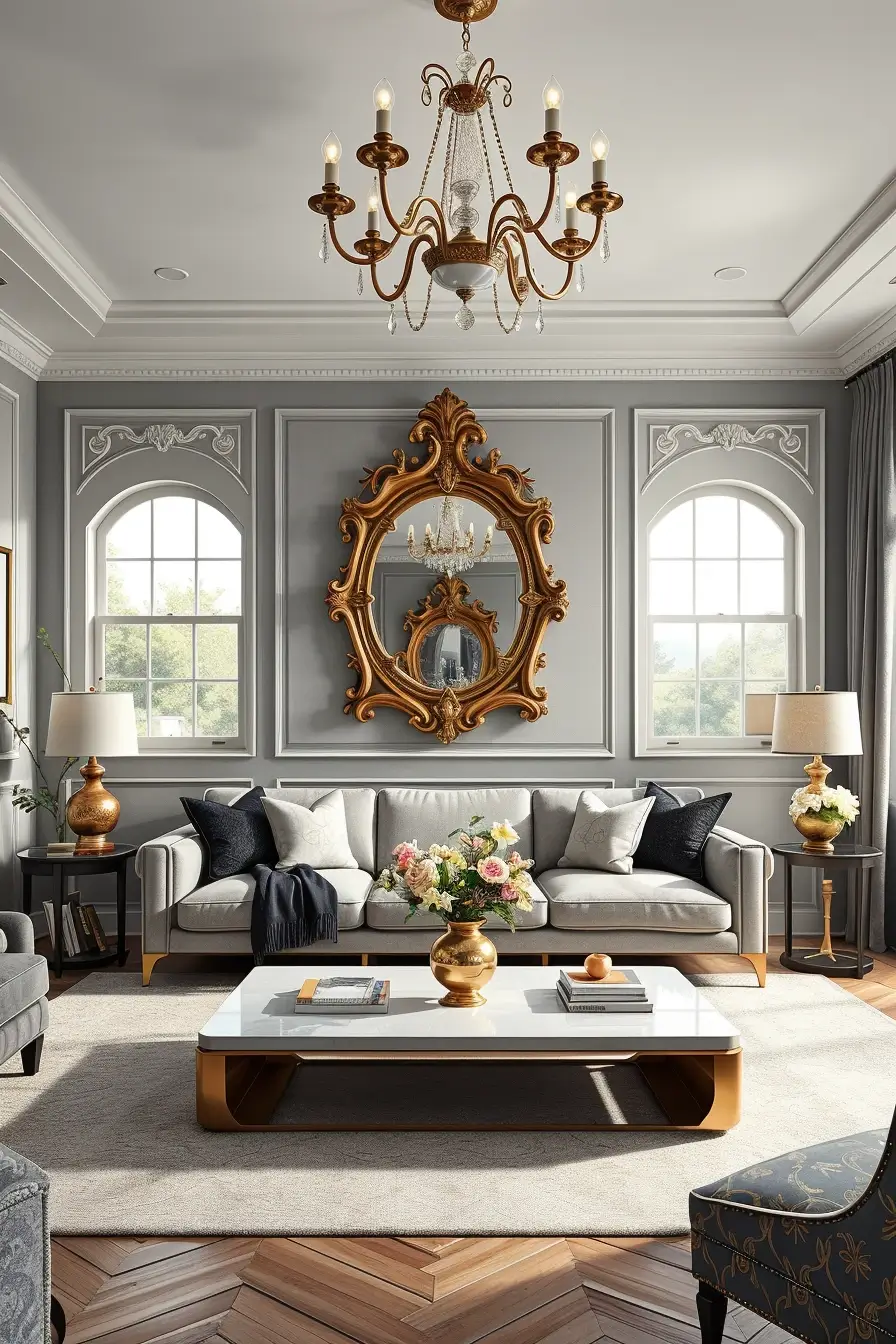
What makes Rococo Revival Home Design so magical and why has it been a classic source of inspiration to both conservative and contemporary homeowners? Are ornate fireplace mantels, gilded decorations and elaborate designs really suitable in modern living quarters? In this article, I will discuss the key features of Rococo Revival interiors and exteriors, including the exquisite furniture and the extravagant decoration, and provide the ideas on how these historical concepts can be easily integrated into the modern houses.
Rococo Revival is about extravagance, craftsmanship and romance. The style originated in the 19th century as a reinterpretation of the Rococo period of the 18th century, and introduced a new interest in curves, gilding, and delicate ornamentation. Whether in the form of fireplace mantels that have elaborate decoration, gold and gilded decoration, or elaborate flooring patterns, Rococo Revival design is still a source of inspiration to those who want a mix of artistry and elegance.
In this guide, I will not only tell you the history and beauty of Rococo Revival but also how to apply it in your interior and exterior designs. Whether it is gardens and landscaping or hallways and kitchens, we will look at balancing the traditional and the modern sensibilities to create rooms that are warm, inviting and unmistakably regal.
Introduction To Rococo Revival Style
The first time I heard about Rococo Revival home design, I was impressed by how it combines the old and the beautiful. The style is inspired by the 18 th century France and focuses on lightness, elaborate decorations, and the feeling of motion that makes the interiors dynamic. The question that most homeowners pose is how can such an ancient style fit in a modern environment without being old fashioned? This is what I would like to discuss in this article.
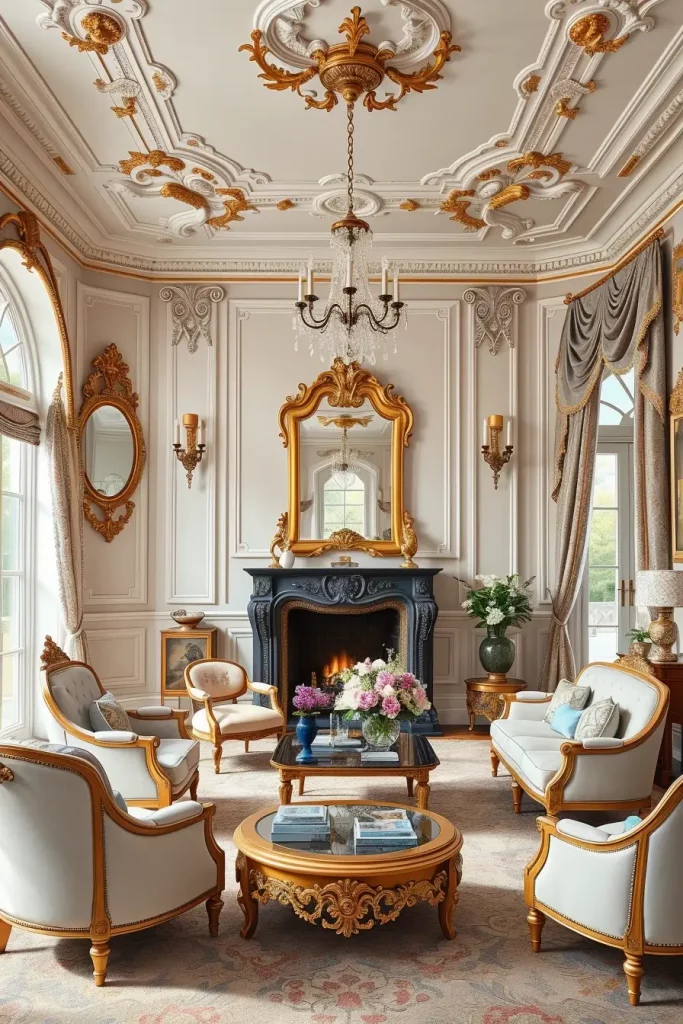
Entering a Rococo Revival interior, the first thing I see is the curves, the ornate carvings, and the pale pastel color schemes that create the atmosphere. The design of the building and the furnishing work together to make the place seem luxurious but surprisingly comfortable. The use of such details as gilded mirrors, flowing drapery, decorative wall panels is the key to creating authenticity.
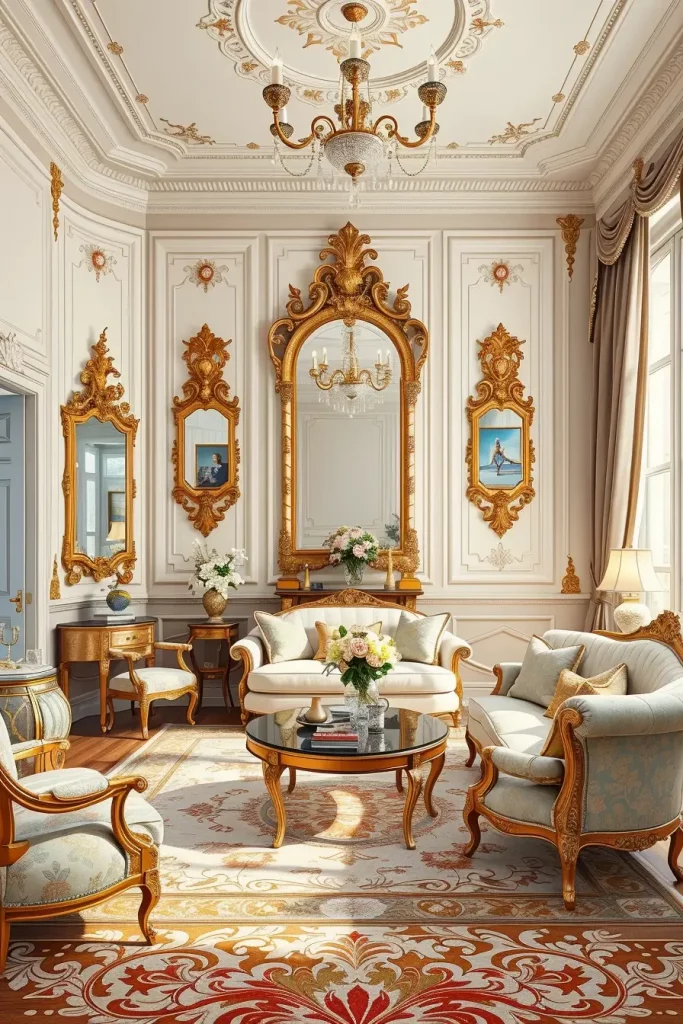
In my opinion, Rococo Revival is so successful nowadays because it does not have to be overpowering. Architectural Digest suggests that the trick to balancing ornate interior design is to combine it with more minimal modern elements to keep the room feeling new. I think this tip is very helpful to any individual who is planning his/her space.
In this part, I would include a more emphatic discussion of why homeowners should think about Rococo Revival as a design option in the present day. It makes it more relevant to point out that it is flexible and can fit in both modern and old houses.
The Origins Of Rococo Revival In Architecture
Speaking about the origins of Rococo Revival architecture, I always refer to the middle of the 19 th century. European and American designers during this period resurrected elements of the Rococo to offset the strict lines of the early century. This new wave was excited about exuberant curves, asymmetry and excessive decoration, which affected both exteriors and interiors.

The Rococo Revival style is characterized by rounded windows, ornate facades, and ornate moldings. The ceilings were high and frequently had panels painted or gilded. I especially like how these features are letting light into the house, which makes it seem playful, even theatrical.

In my opinion, it is critical to keep in mind that Rococo Revival was not merely focused on luxury, but it was also concerned with artistry. Most of the houses of this period were designed by artisans who specialized in detailed woodwork and plasterwork. This workmanship creates a depth that is lacking in mass-produced products in the modern day.
To conclude this section, I would add examples of some of the most prominent Rococo Revival houses in the US and Europe. This would provide a clear image to the readers how far and wide the style spread and how influential it was.
Defining Characteristics Of Rococo Revival Interiors
Elegance, detail, and fluidity are the key characteristics of Rococo Revival interiors in my opinion. The use of curves, scrollwork, and elaborate ornamentation instead of straight lines in each space makes it feel lively. These interiors are created to make the eye move around the room in a constant movement.

I tend to use curved sofas, carved wooden chairs and gilded mirrors when decorating a Rococo room. These pieces of furniture reflect the luxurious and yet welcoming nature of the movement. The room is complemented with richly decorated wallpaper and drapery to add to the overall effect of the room, and bring the aesthetic together.
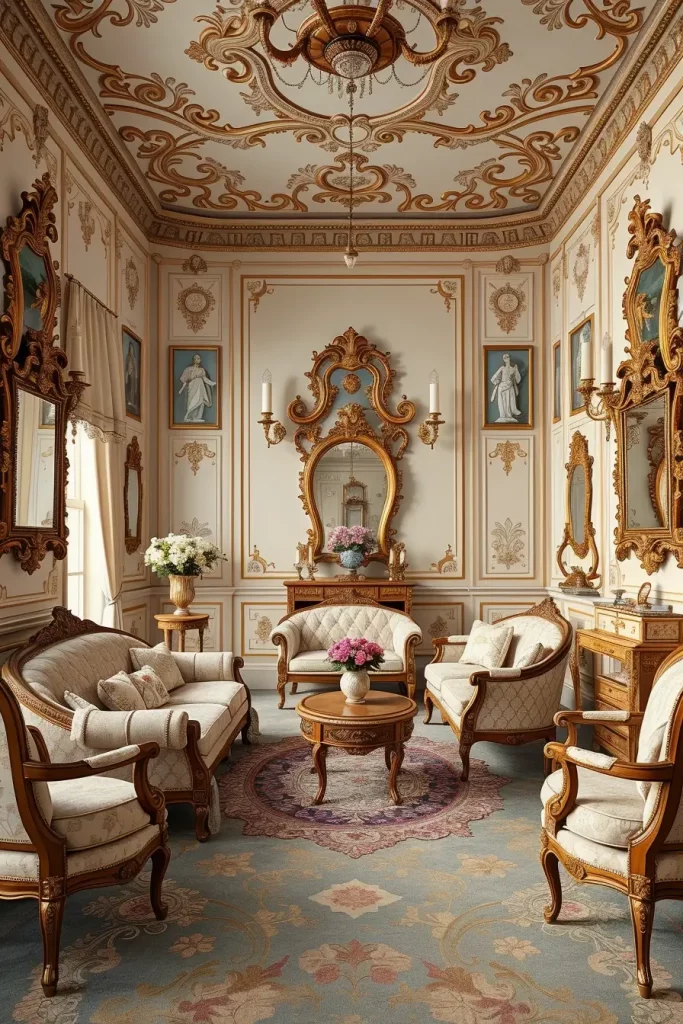
In my personal work, I have discovered that Rococo Revival interiors are perfect to create a stately yet whimsical room. Designers such as Miles Redd, writing in Elle Decor, recommend overlaying heavy patterns with light colors to avoid the design being too heavy. I have witnessed this strategy be successful in practice.
The thing lacking here is a more detailed look at how smaller contemporary houses can incorporate Rococo Revival without making it too cluttered. This section would be even more helpful with a practical advice on scaling down.
The Influence Of French Aristocratic Aesthetics
Rococo Revival is based on its relation to the French aristocratic tastes. The style is inspired by 18 th century Parisian salons and focuses on luxury, refinement, and comfort. I adore the way these interiors are an expression of a life of leisure, art and conversation.
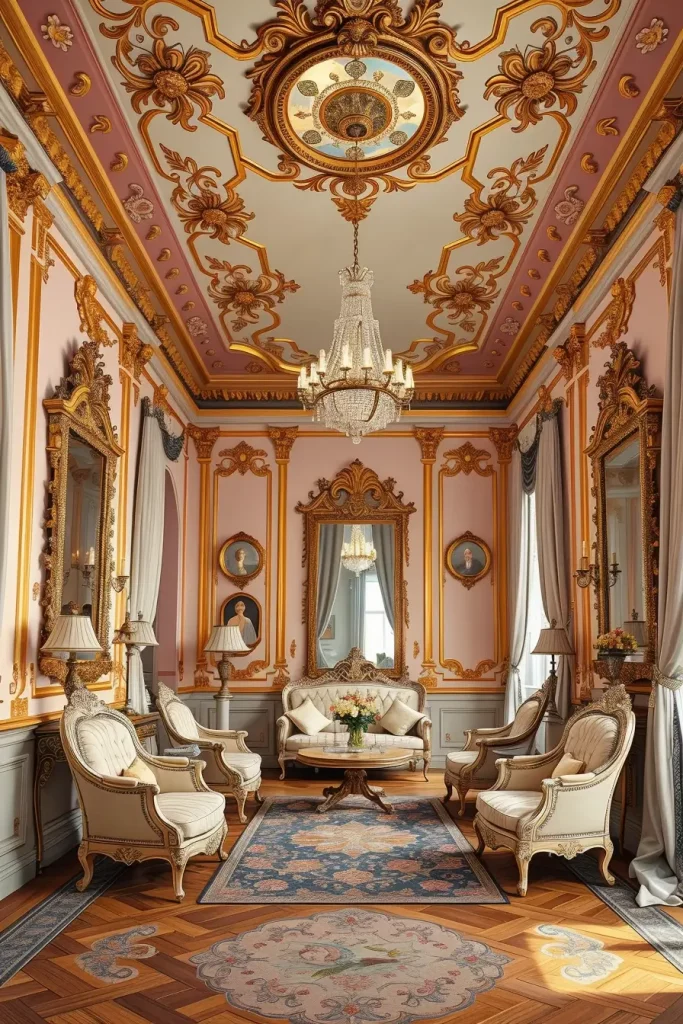
Such design features as gilded moldings, pastel walls, and decorative furniture resemble the magnificence of French palaces. In my personal style, I always use mirrors with rich frames because they immediately remind of the aristocratic style and give depth to any room.
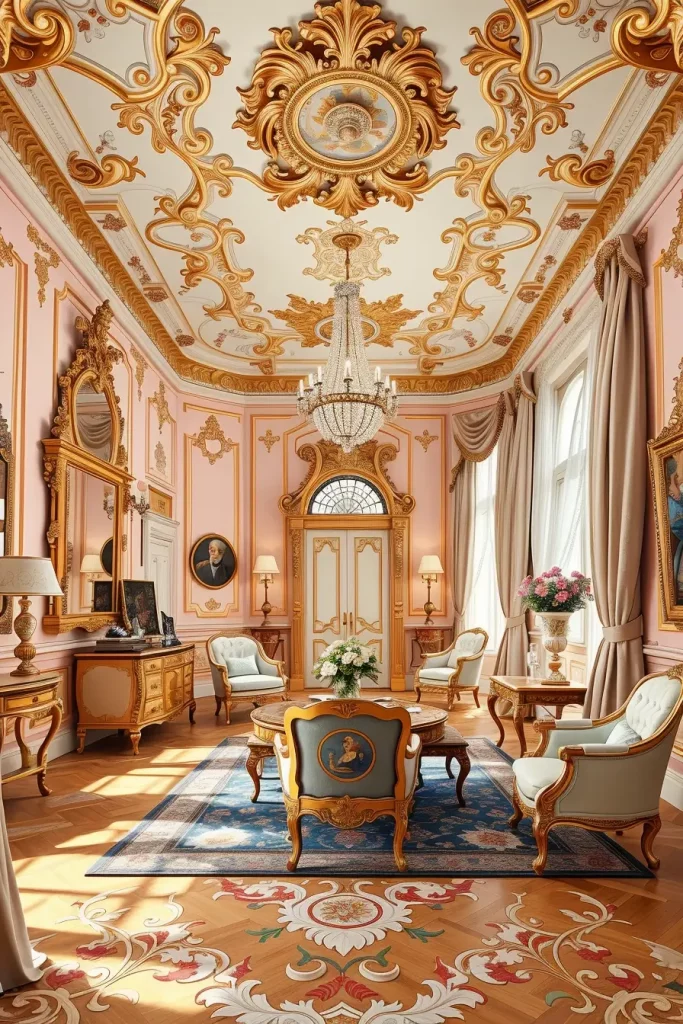
French aristocratic aesthetics, in my opinion, reminds us that interiors are not only supposed to be functional but also emotional. House Beautiful once pointed out that Rococo interiors are an ode to visual pleasure, and that is why they are still relevant centuries later.
To this part I would add some practical hints as to the adjustment of aristocratic luxury to modern economy. It would be a good idea to recommend simple decor options to make the design more friendly to a broader audience.
Rococo Revival Color Palettes For The Home
The first thing I do when creating a Rococo Revival room is to establish the color scheme as it determines the mood of the rest of the room. Light blues, golds, creamy whites, and soft pastels prevail in the scheme. These colors are reminiscent of the airy romanticism of the style.
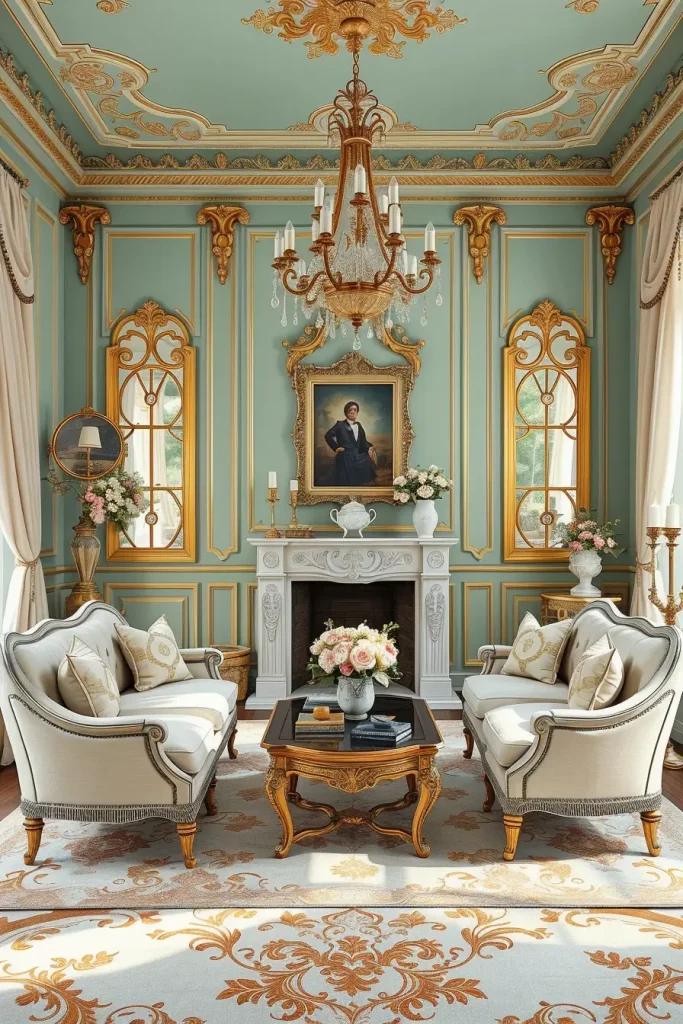
I love to combine pale pink or mint walls with gilded details, and ivory upholstery. I choose furniture covered in damask or silk, which looks amazing against these light colors. The mixture is classic and elegant.
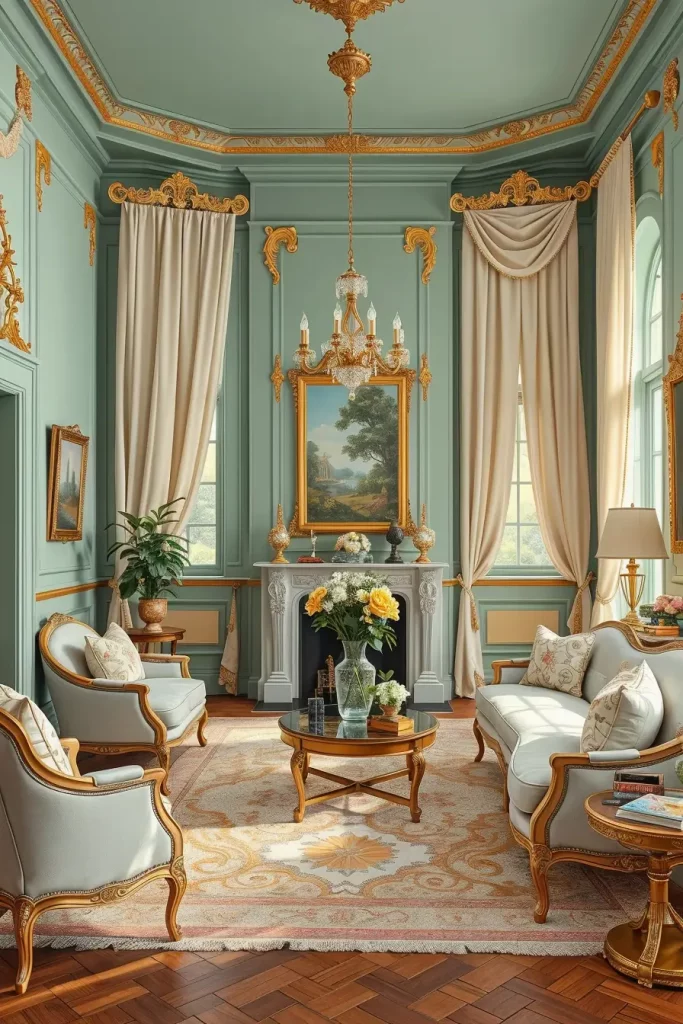
In my opinion, Rococo color schemes are versatile and a lot of people do not realize it. You can go lighter with the shades to have a playful effect or keep it muted with creams and golds to have an elegant effect. According to designers like Bunny Williams, it is a good idea to balance rich upholstery with soft wall tones, so as not to overwhelm the room.
This section might be improved with advice on how to use contemporary paint finishes or wallpapers to recreate the traditional Rococo effects but in a practical maintenance situation.
Decorative Wall Panels And Moldings
Decorative wall panels and moldings are also one of my favorite elements of Rococo Revival interiors. These details give a texture and depth, transforming a dull wall into a work of art. They are, in my opinion, the most important thing to introduce the authentic Rococo charm into the modern house.
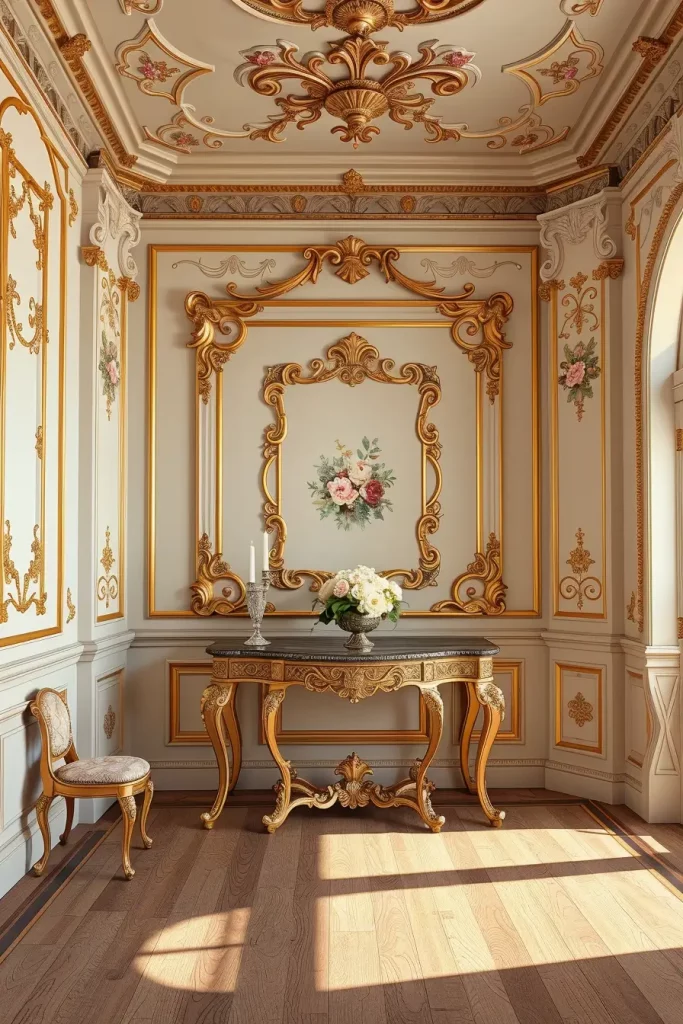
I usually suggest the addition of wainscoting, carved moldings or gilded frames to accentuate focal walls. Panels with scroll or floral designs are particularly successful. Combined with the pastel colors of the walls, the design does not seem excessive.

In my opinion, wall panels produce the effect of luxury without the need to renovate. Veranda magazine says that decorative moldings are among the most cost-effective methods of enhancing a space and paying tribute to historical designs. I have witnessed homeowners get dramatic results with little investment.
I would reinforce this section with some real-life examples of how to combine moldings with modern art or mirrors. This tip would demonstrate to readers how to incorporate old world style with the current aesthetic tastes.
The Role Of Mirrors In Rococo Revival Design
When I consider the Rococo Revival, one of the first things that I think of is the use of mirrors. They are necessary to add depth and lightness to the interiors. Large, gilded frames, with elaborate carvings are typical in this design.

I usually add a statement mirror above a fireplace or console table The elaborate frames not only act as focal points but also reflect light around the room to enhance the pastel colours and gilted details of the furniture and decor.
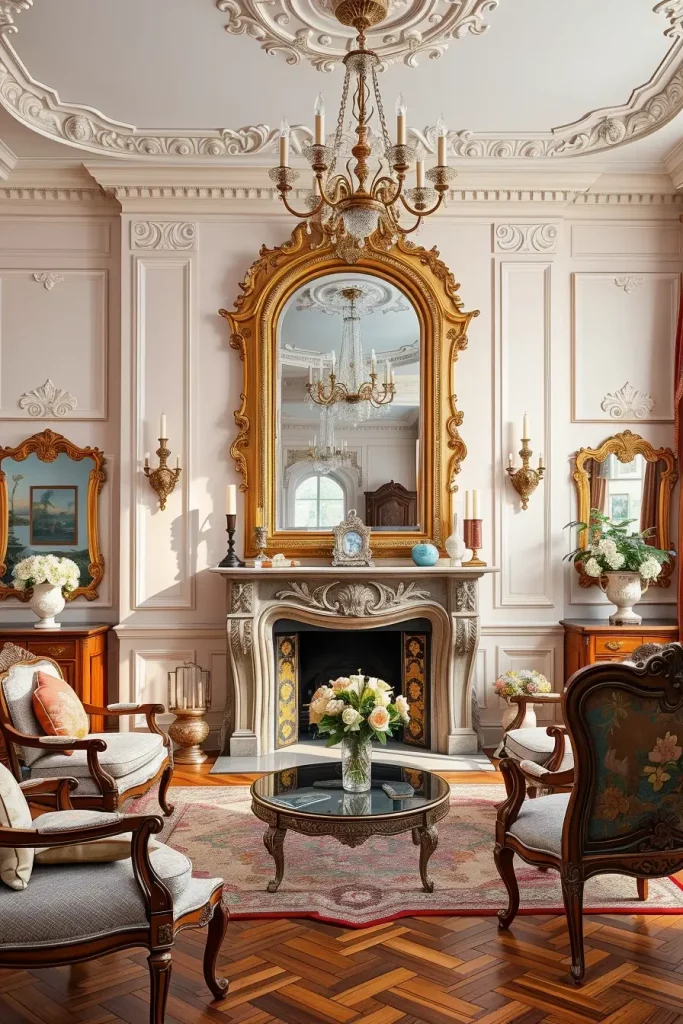
In my professional judgment, mirrors also represent the playful aspect of Rococo design. They reflect chandeliers, wall panels, and fabrics, and make the space more dynamic. Designers at Architectural Digest have emphasized how mirrors can make smaller rooms feel larger- something I have found to be true in practice.
I would finish this section by adding the ideas to combine antique-style mirrors with contemporary lighting pieces. This brings a harmony between the classical beauty and modern lifestyle.
Curved And Ornate Furniture Styles
The most notable feature of the Rococo Revival furniture is the application of curves and ornate designs. When I am creating interiors in this style, I seek out chairs, sofas, and tables with flowing lines that resemble those of nature such as shells and vines. These details add a feeling of motion which is light and fluid.
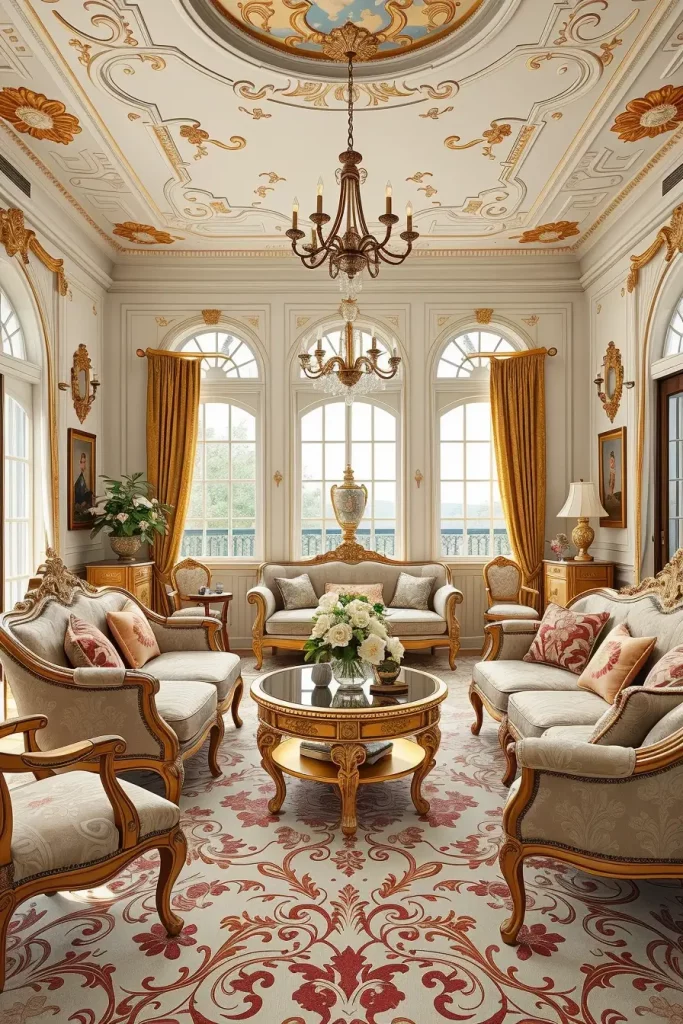
I usually prefer gilded or painted carved wood furniture. Silk or velvet upholstery makes the room rich, and the curved headboards and cabriole legs make it authentic. All of them are like works of art and this is why they can make a plain room look like a Rococo masterpiece.
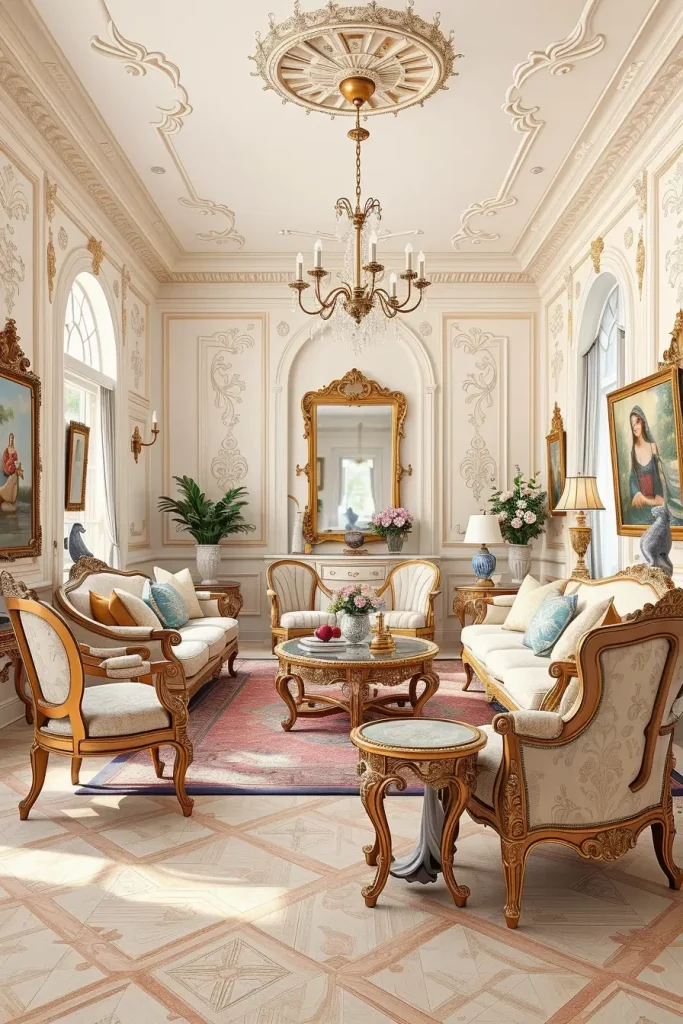
I am personally surprised by how versatile curved and ornate furniture is. Designers at House Beautiful suggest matching Rococo chairs with more simple pieces so that the room does not look too much. I have used this tip in numerous projects and it is a beauty.
I would add some information on how to find reproductions or antiques to this section, as readers are usually interested in knowing where to find authentic Rococo-style furniture in the modern world.
Rococo Revival Bedroom Inspirations
When I am decorating a bedroom in Rococo Revival, I want to make it romantic and elegant. The basis of the style is pastel colors, flowing robes, and gold decorations. The most important thing is a grand bed with a carved and upholstered headboard.

I typically incorporate matching nightstands with a lot of detailing, curved dressers and armchairs. Hanging lights or fancy sconces provide flattering, soft light to the room. The luxurious materials such as damask or satin add the feeling of intimacy and grandeur.
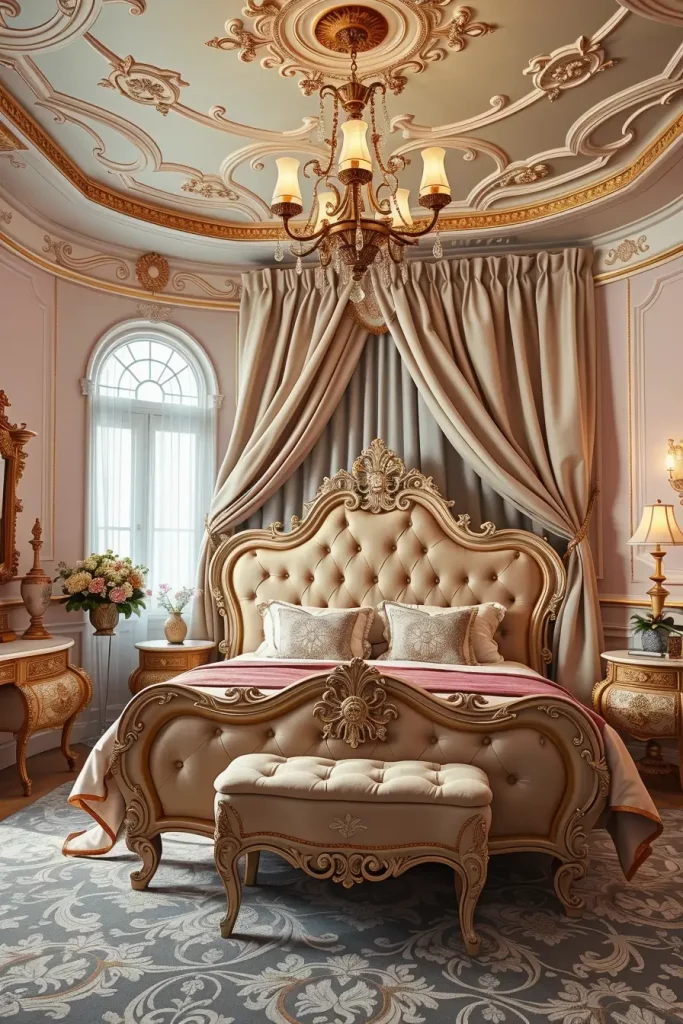
I think Rococo Revival bedrooms are more than just beautiful: they are a place of comfort and art. Elle Decor suggests that patterns in bedding and curtains create a depth in the bedroom without making it look too busy. I have found that a great piece of advice.
This section can use some additional suggestions on how to introduce modern necessities, such as discreet storage, without losing the grace of the style.
Living Rooms With Rococo Grandeur
When I create a living room that is Rococo Revival, I would like it to be grand but not intimidating. The feeling of grandeur is achieved with the help of high ceilings, decorative moldings, and flowing layouts. The mirrors and chandeliers are large and contribute to the airy, spacious effect.
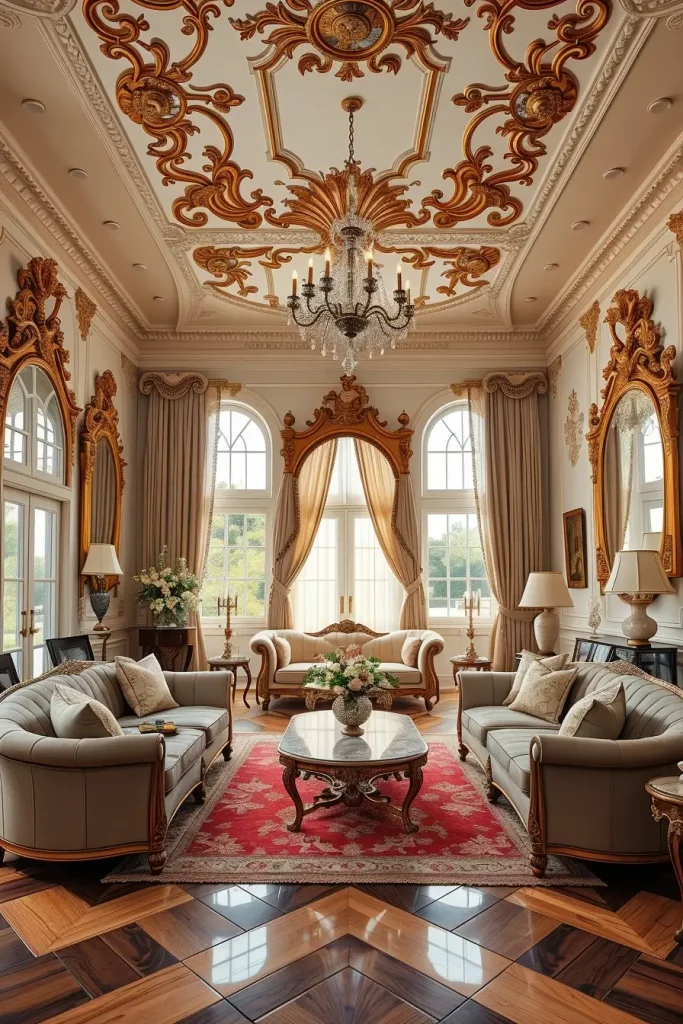
As furniture, I would prefer curved sofas, gilded tables and accent chairs with elaborate carvings. A marble-topped coffee table or a console with ornate legs is used as a focal point. Ornamental textiles, silk curtains or embroidered pillows, create a sense of coziness and elegance.
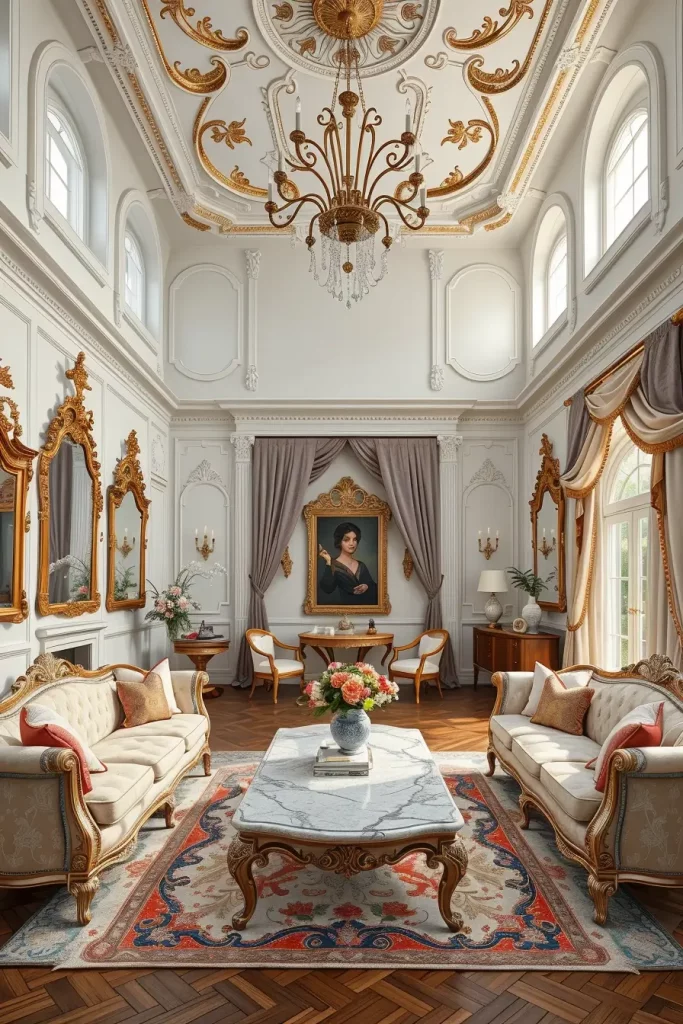
In my opinion, Rococo Revival living room is about drama without weight. According to Veranda magazine, the combination of rich decorations with pastel colors will make the room luxurious yet not overwhelming. I have used this concept to combine beauty with practicality.
The only thing that can make this section more effective is the note on how to incorporate entertainment systems or contemporary pieces of furniture without disrupting the historic look.
Dining Rooms Inspired By Rococo Elegance
One of the most charming rooms to display Rococo Revival is the dining room. I think that the style is also a natural fit with formal dining traditions, as it is detail-oriented and atmosphere-oriented. A big, fancy dining table is a quick way to establish the mood.

I usually combine the table with carved chairs covered with silk or velvet. Crystal details of the chandeliers add glittering light, and gilded mirrors and wall panels reflect the magnificence of the room. Sideboards or buffets with fancy finishes are also necessary to store and also to add style.

Rococo Revival dining rooms are, in my experience, those in which meals become ceremonial. Designers who write in Architectural Digest point out that even plain food can be made special by the use of Rococo-inspired lighting. I concur totally
To complement this section, I would include more details on how to include floral decorations and tableware that does not overpower the Rococo style.
Luxurious Fabrics And Upholstery Choices
When I consider Rococo Revival interiors, fabrics are the first thing that come to my mind. They determine the texture, softness and luxury of the space. My favorite materials are damask, silk, and velvet as they are light-reflective and luxurious to touch.
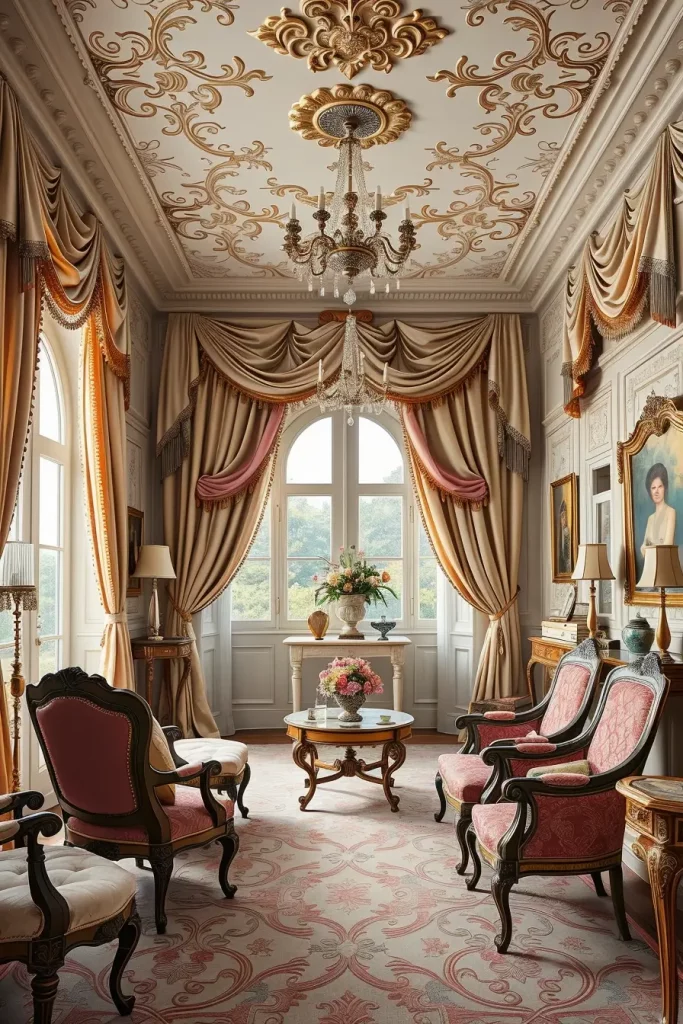
My upholstery pattern is floral, scroll or damask, which directly relates to Rococo traditions. Curtains and draperies with thick tassels and layered curtains are romantic and dramatic. Upholstered walls, less frequently used nowadays, can also create a historic feel of authenticity.

In my opinion, fabrics play a major role in balancing the Rococo ornamentation. Designers such as Miles Redd recommend the use of bold patterns in small doses and letting upholstery do the heavy lifting of the style. This is what I have found to be a harmonious effect.
This section may also include recent advances in fabrics, which enable a homeowner to achieve the Rococo Revival style without compromising on functionality, e.g., stain-resistant velvets.
Chandeliers And Lighting In Rococo Revival Homes
Lighting plays an important role in Rococo Revival interiors, and to me, chandeliers are essential. Their crystals and metalwork are ornate and reflect the glamour of the times as well as providing a functional light.
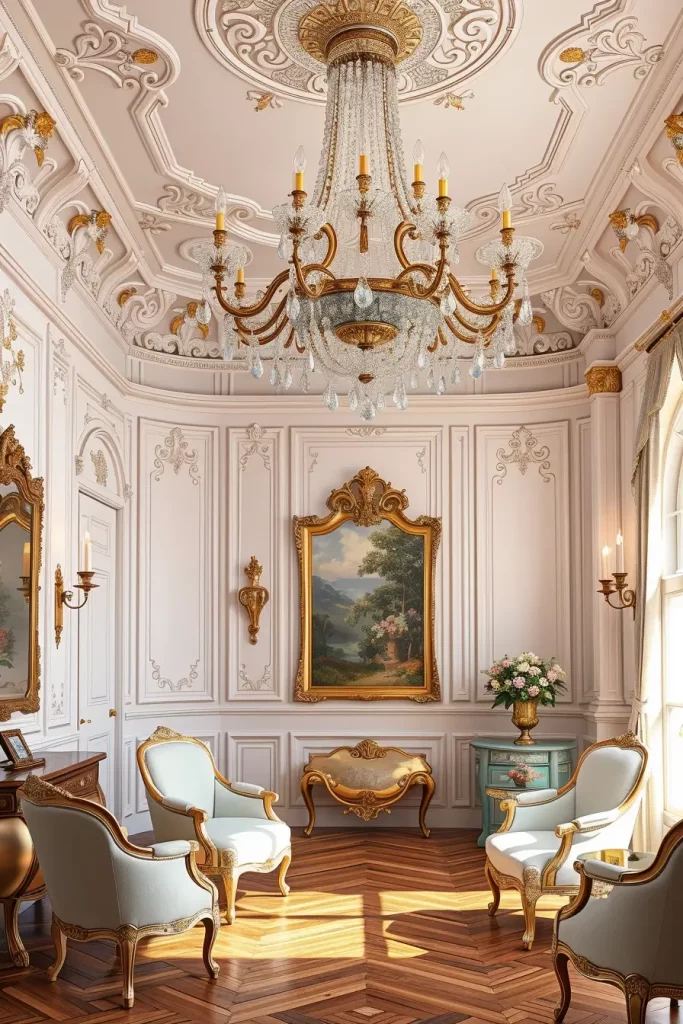
I usually prefer chandeliers with gold or bronze finish and I usually put them in the living room, dining room or bedroom. Wall sconces with gilded decorations are added as a complement. Candlestick-style bulbs add to the historical feel and the wiring is modern and safe.

To my professional judgment, chandeliers are not only a source of light but also a piece of statement that determines the level of elegance of the room. According to designers who write in House & Garden, chandeliers are to be considered as the objects of focus, just like artworks. I fully concur with this view.
To reinforce this part, I would include the recommendation to incorporate dimmers and layered lighting systems, which will enable the owner to manage atmosphere and retain Rococo character.
Rococo-Inspired Ceiling And Wall Murals
Among the most spectacular aspects of Rococo Revival is the painted mural on ceilings and walls. I have always liked how these designs can form a complete environment, which can be pastoral, floral, or mythological.

When I create such spaces, I advise the use of pastel backgrounds with gold frames to bring out the art. Cloud or cherubs on ceilings give the room a heavenly touch, and scrolling vines on wall murals tie the design together with the rest of the room.
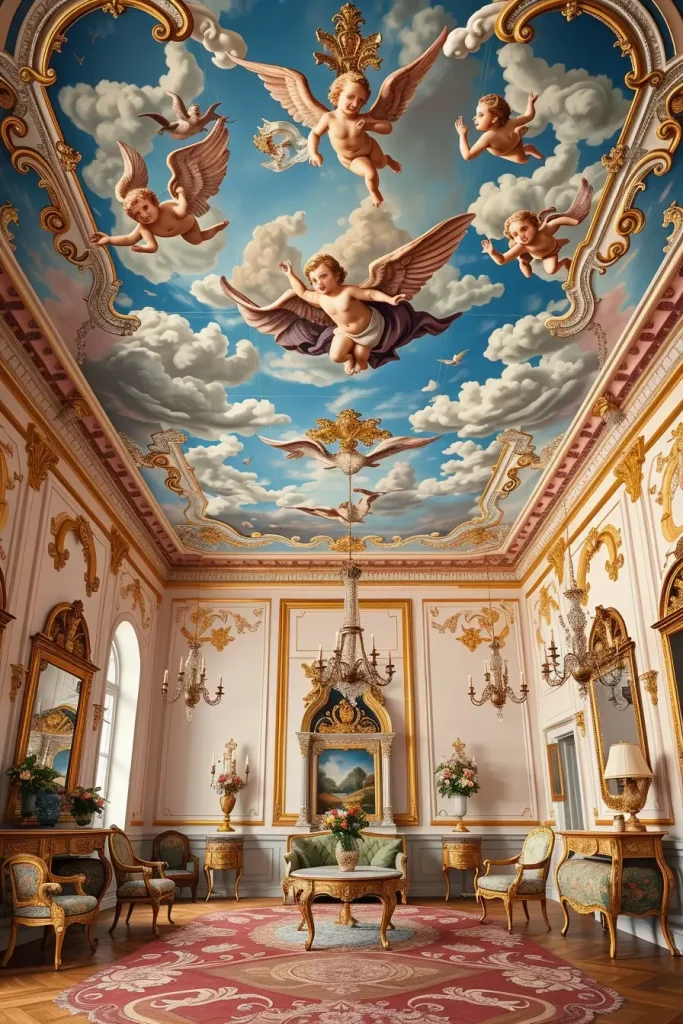
To my mind, murals are where Rococo Revival interiors become artworks. Architectural Digest says that ceiling murals were initially created to evoke a sense of wonder and they still have a statement to make in contemporary homes. I have witnessed them turn a normal ceiling into a masterpiece
This section can be improved by proposing contemporary solutions such as wallpaper murals or digital prints, which would make such level of artistry more affordable to the contemporary homeowner.
Fireplace Mantels With Ornate Detailing
When I think of Rococo Revival interiors, the first thing that comes to mind is the fireplace as the focal point of the luxuriousness. A fancy mantel with intricate carvings, flower designs, and gold-plated borders immediately establishes the mood in the room. The value of such an element is not only in its aesthetic effect but also in the comfort and coziness it gives to the living space, grounding it in a manner that attracts the eye and the soul.
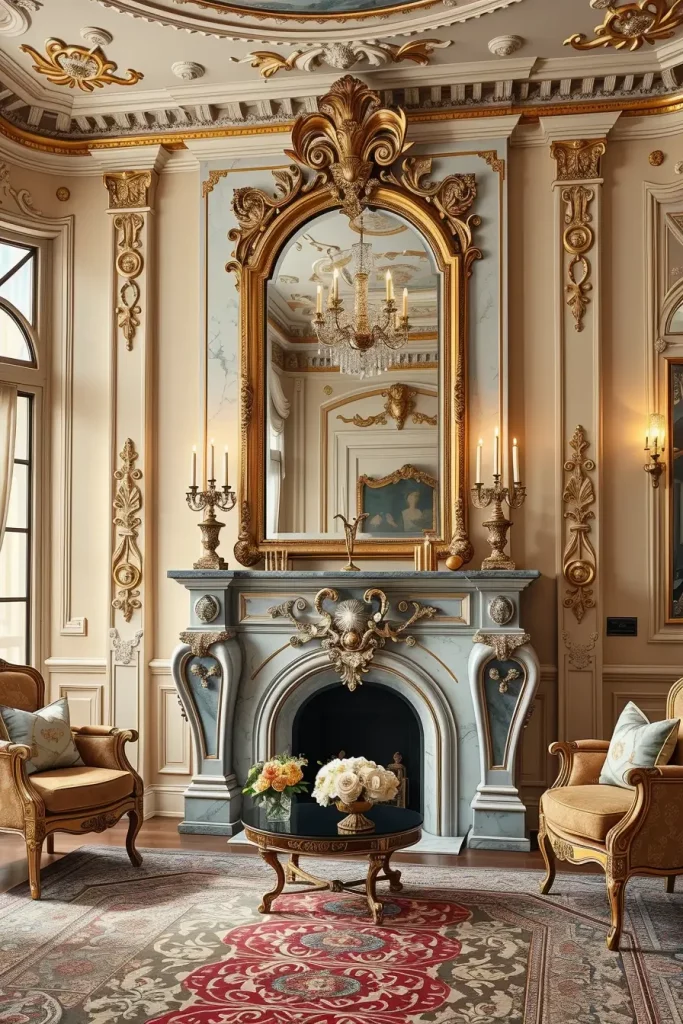
I would always suggest that the fireplace mantels should be made of marble or wood that is stained heavily as these materials are reflective of authenticity and luxury. The mantel is surrounded by gilded mirrors, candelabras, and well-selected artwork that underlines the grandeur of the room. The plush armchairs and patterned rugs add a balance to the ornate detailing, so the space is not only impressive to look at but also comfortable to live in.
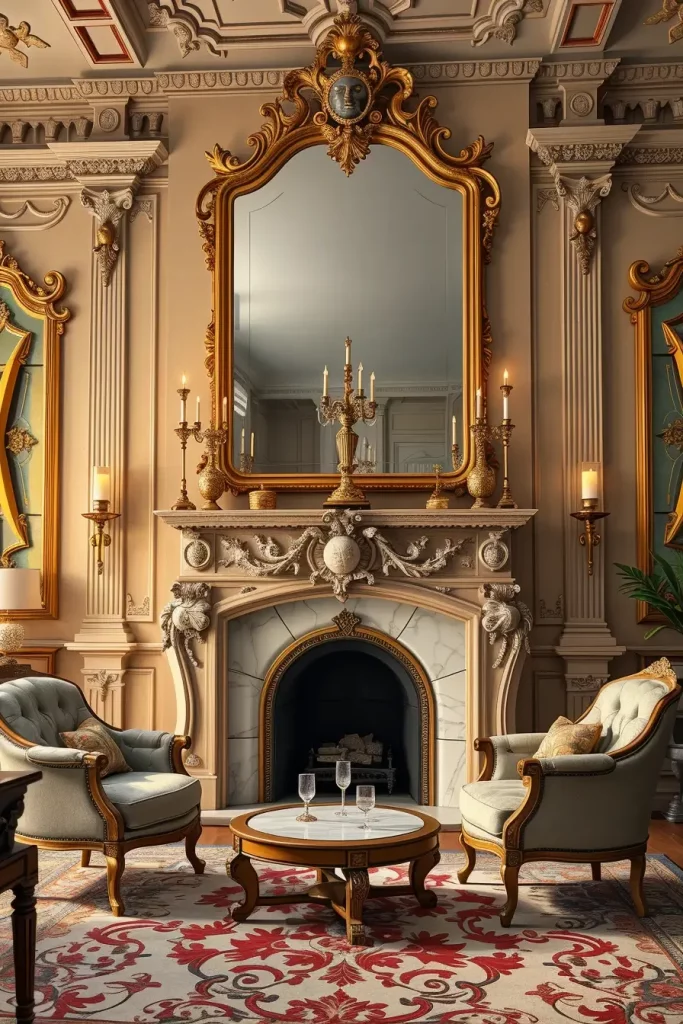
In my practice, the clients who are interested in upgrading their living areas usually begin with the fireplace. According to Architectural Digest, a fireplace serves as an “architectural focal point” that dictates the tone of a room. I have witnessed personally how a Rococo inspired mantel can take a simple room and make it feel like it has been there forever and welcoming.
The thing that I would add here is the incorporation of modern functionality. The installation of a gas or electric insert into the ornate mantel design would allow the feature to be functional in everyday life, thus filling the gap between the old and the new.
The Use Of Gold And Gilded Accents
Gold and gilded elements are the core of Rococo Revival, and they provide warmth, shine, and the feeling of high-quality. These details can improve the interiors without making them too busy when applied in a considerate way. The functionality of gilding is that it emphasizes the architectural details and decorative items, attracting attention to the best details of the room.
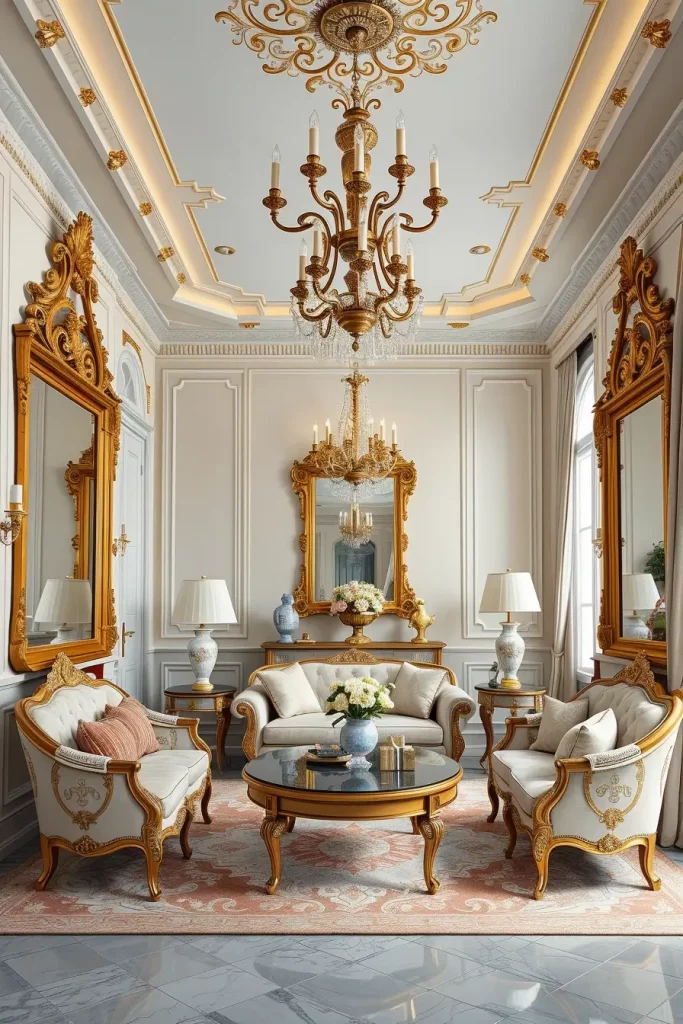
I normally gild furniture frames, wall mirrors, picture frames and chandeliers. A coffee table or sofa with gilded edges can be a very striking but elegant design. Combining these accents with soft pastel colors of the walls or muted fabrics will make the shine feel balanced and not overwhelming.

In my opinion, gilding is not only about decoration, it is about storytelling. As Elle Decor has observed, gilded finishes provide a sense of classical style that can be used to bridge the gap between modern and classical styles. Clients also tend to be infatuated with the warm glow of gilded accents in their rooms.
To finish off this section, I would recommend the use of gold sparingly but with purpose. One or two gilded statement pieces can also make the interior luxurious without making it excessive
Rococo Revival Flooring Ideas And Patterns
Flooring is an element that is usually neglected, but in Rococo Revival houses, it is a key element. Delicate parquet patterns, marble inlays and darkly stained wooden floors provide depth and support the opulent style of the interior. Practically, these designs are long lasting and give a classy foundation to all the other decorations in the room.

I would usually suggest parquet flooring with curvilinear patterns or floral-inspired patterns. Marble with gilded inlays can be used in living rooms and dining rooms to produce an impressive effect. Rugs with Rococo-inspired patterns can also make the look softer and warm, especially in bedrooms and hallways.
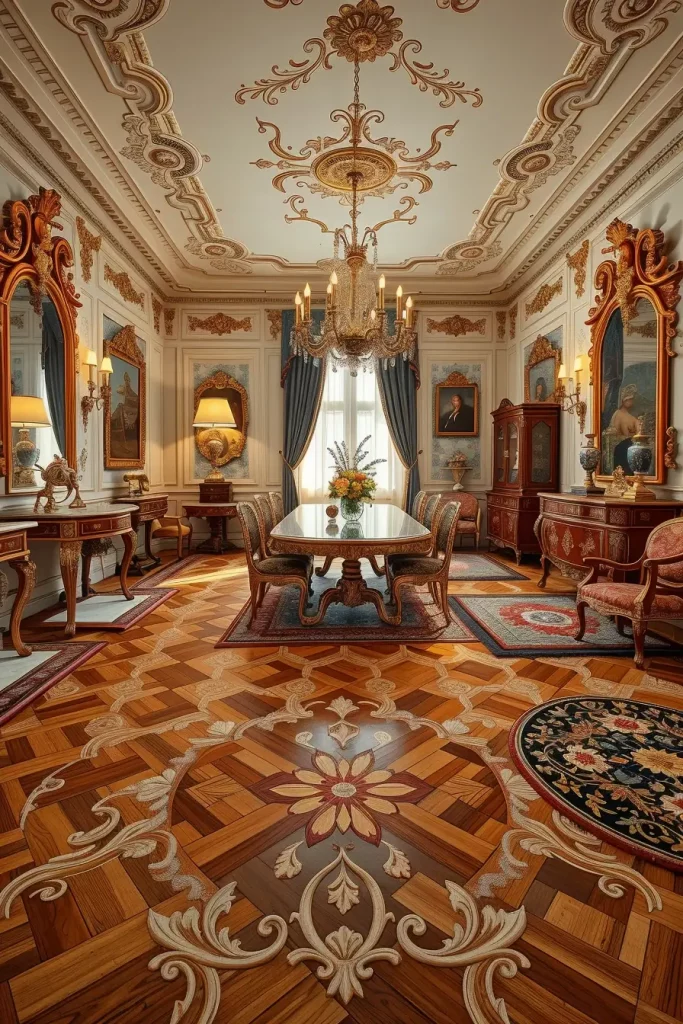
As a personal opinion, I think that Rococo Revival flooring is one of the most adaptable parts of the style. Designers like Bunny Williams have stressed the significance of flooring as a base of the whole room and I can not agree more. The floor is designed in a very beautiful manner that makes it compatible with the furniture, walls, and accessories.
The only thing I would add here is the possibility to combine classic patterns with more modern materials such as luxury vinyl or engineered wood, which has the same visual effect but is cheaper and easier to clean.
Incorporating Rococo Revival In Modern Homes
The question I often get is whether Rococo Revival can be used in contemporary settings. The answer is yes–if done intelligently The functionality lies in the ability to combine the elements of ornamentation with simple lines, so that the style does not overpower a modern house.
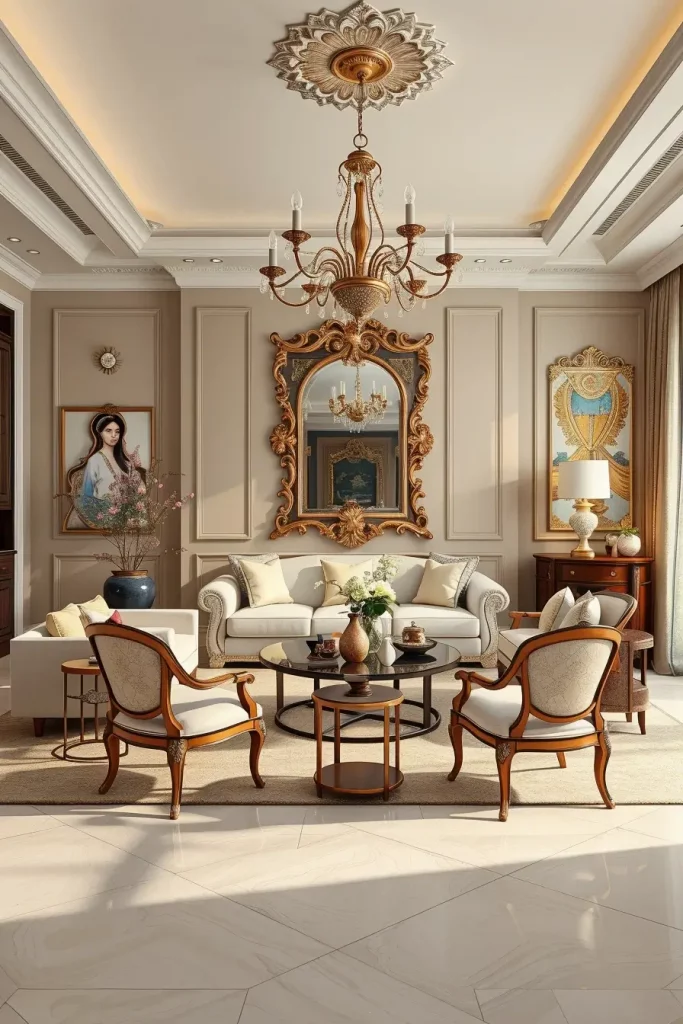
I would usually recommend adding one or two statement items, such as a gilded mirror over a streamlined console or a fancy chandelier in a minimalist dining room. Curved-leg furniture or rocaille carvings can be used surprisingly well with modern neutral upholstery. It is all about balance.
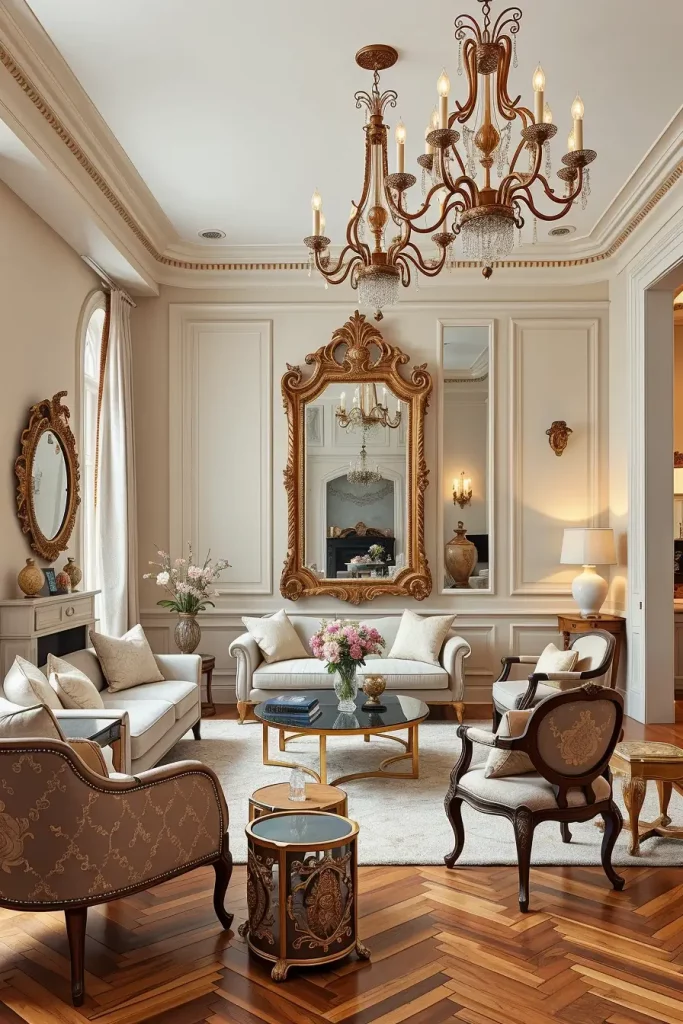
In my opinion, Rococo Revival in contemporary houses is about contrast. The House Beautiful notes that a combination of styles can produce a visual tension that is dynamic and fresh. I have observed how one little Rococo-like touch, such as an armchair, can take the edge off the severity of a modern room.
I would add lighting to this. Warm, layered lighting is also used to accentuate the gilded and ornate details and make the atmosphere cozy and approachable.
Outdoor Rococo Revival Design Elements
Rococo Revival is not limited to interiors only; it is applied to outdoor spaces as well. Fancy garden gates, wrought-iron railings with scrollwork, and terraces with curved balustrades all play a part in the overall design story. These features are practically more appealing to the eye and create a feeling of grandeur prior to entering the house.
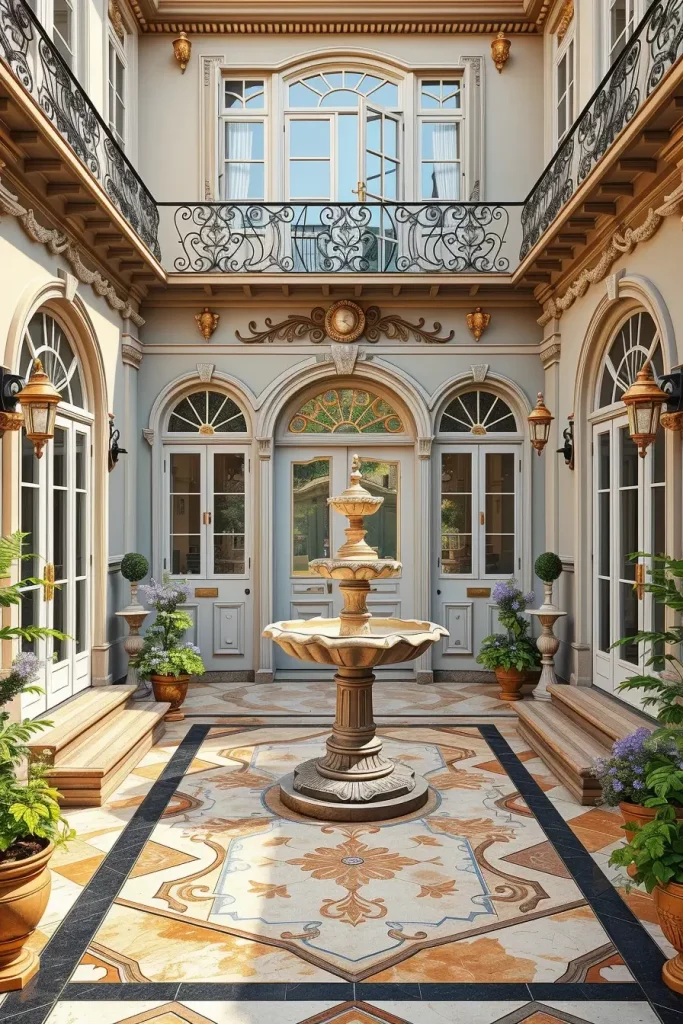
I usually suggest the use of carved stone fountains, wrought-iron benches, and symmetrical pathways that imitate Rococo patterns. Arched windows and French doors to patios can add the interior elegance to the outside. Outdoor lighting with gilded lanterns also adds to the atmosphere in the evenings.

I think that outdoor Rococo Revival style makes a house a message of the luxury. Veranda Magazine states that outdoor spaces that have historical references create an extension of the personality of the home. I think such details on the exterior make harmony between the architecture and the surrounding landscape.
What I would like to add here is the use of durable modern materials. Metals and stone that are weather-resistant and powder-coated enable homeowners to have the intricate appearance of Rococo without sacrificing durability.
Rococo Revival Gardens And Landscaping
The Rococo Revival gardens are created to be beautiful, recreational, and narrative. The usefulness of such landscapes is that they bring harmony between the structured nature and ornamental design. Sinewy walkways, flower gardens, and fountains all reflect the light-heartedness of Rococo.
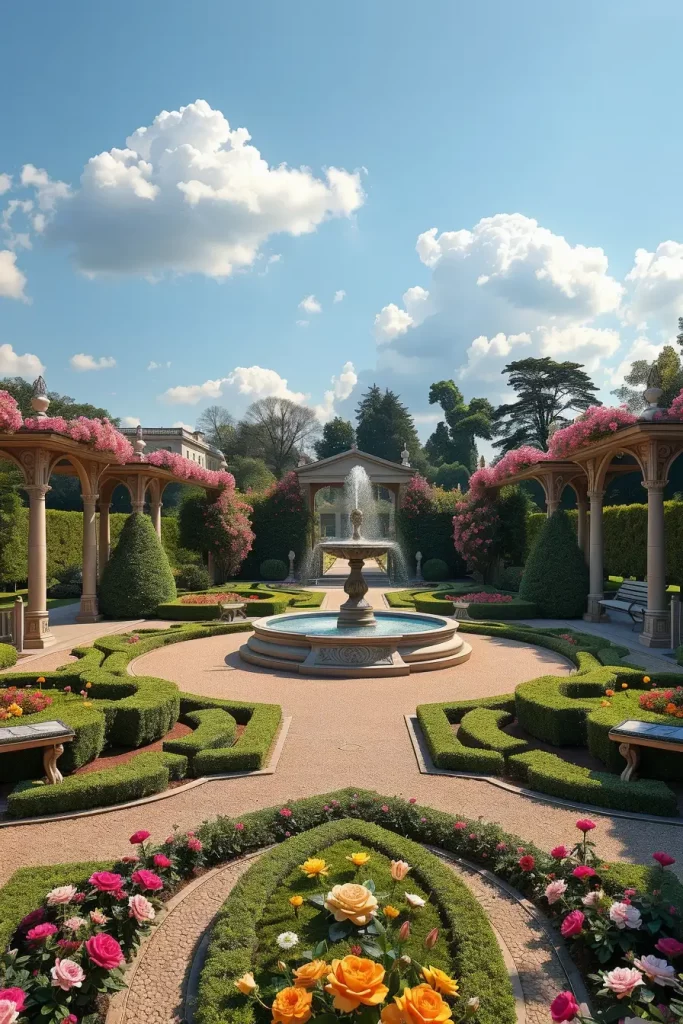
I prefer to use symmetrical garden designs with a central fountain, trellises with climbing roses and benches in shady alcoves. The hedges are shaped and the flowerbeds are ornamental, which adds sophistication and brings visual pleasure.
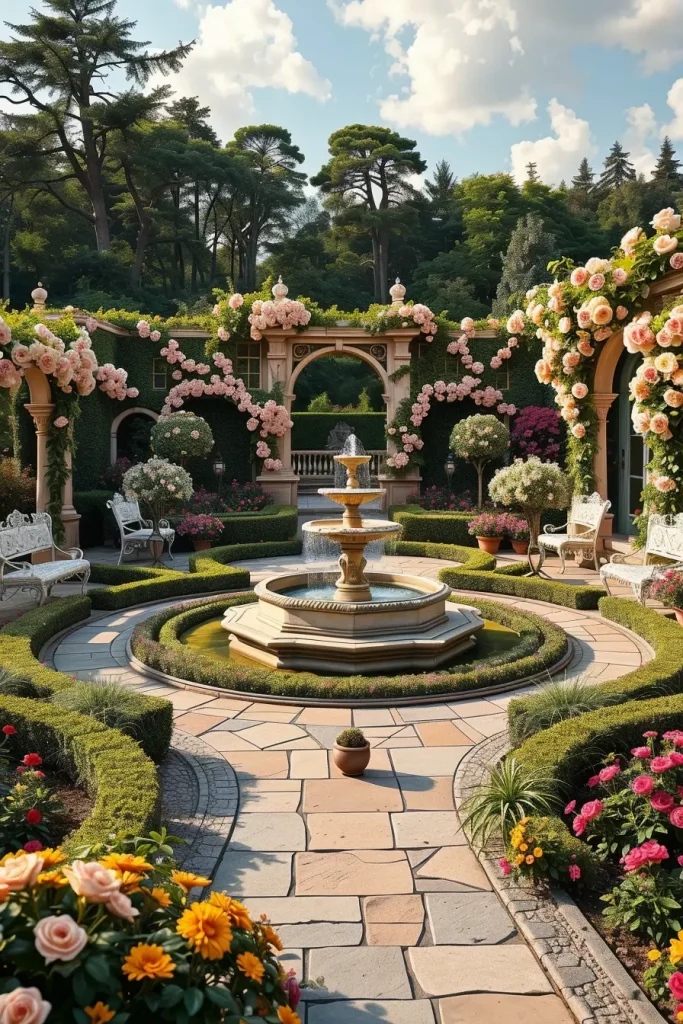
I personally feel that these gardens are therapeutic. The New York Times has observed that historical gardens can bring a sense of order and calm to the contemporary lifestyle and I have seen how clients appreciate their outdoor rooms more when they are designed in Rococo style.
What I would add here is low-maintenance solutions, such as drought-resistant plants in symmetrical patterns, which would keep the aesthetic but be practical to the modern homeowner.
Sculptures And Decorative Accessories
The Rococo Revival interiors are completed by accessories. These objects include sculptures and porcelain figurines representing the playful, yet sophisticated, nature of the style. In practice, accessories are multipurpose- they can be removed or replaced to update the room without making major changes to the design.
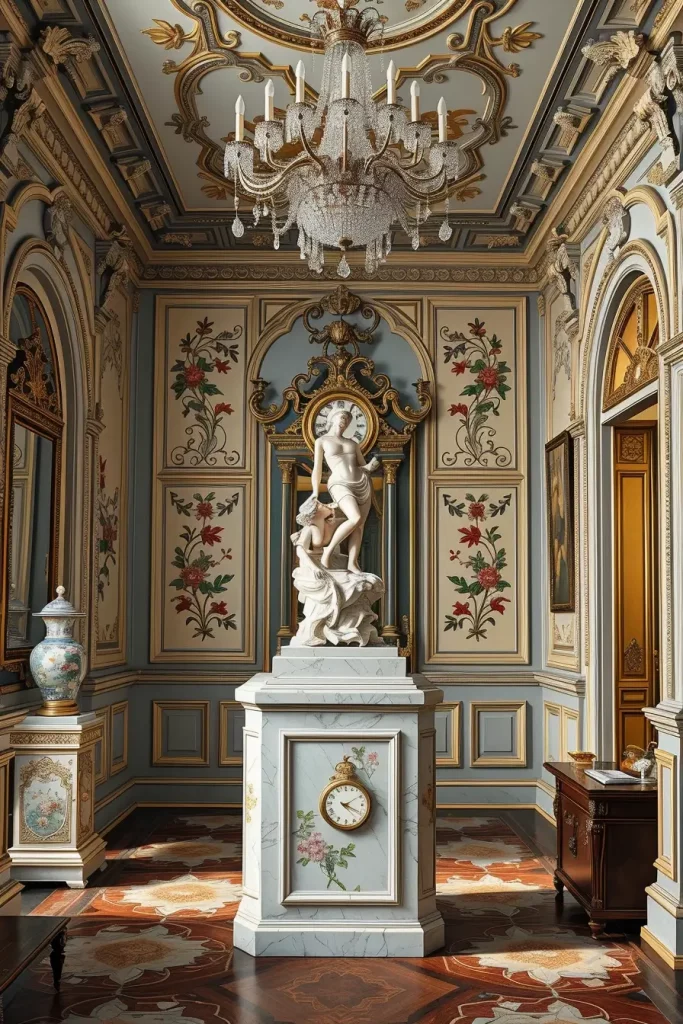
I frequently advise the placing of sculpture on mantelpieces, on console tables, or in hallways, upon pedestals. The luxurious feel is enforced with porcelain vases, gilded clocks, and crystal chandeliers. The accessories are connected to the rest of the scheme by adding textiles with Rococo-inspired embroidery.
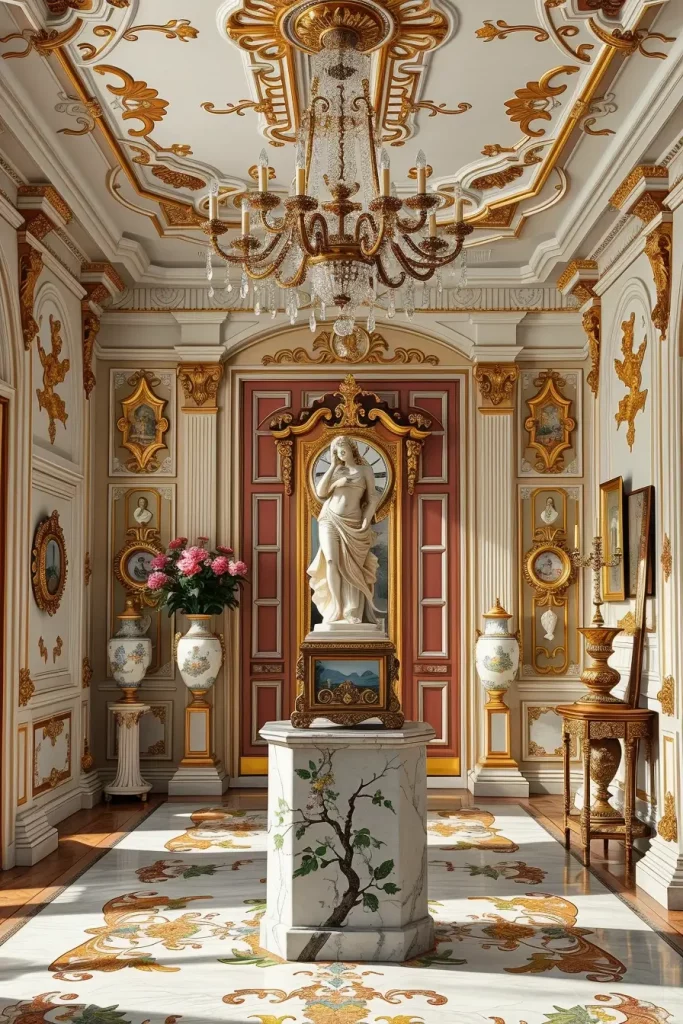
I believe that accessories are the place where the homeowner can have the most fun. House & Garden says accessories make a space personal and show what the owner likes. I always advise clients to select their accessories well so that they serve a purpose in the narrative of the room.
To complement this section, I would propose the presence of large scale statement sculptures in outdoor areas to counter smaller accessories in the interior with something dramatic.
Rococo-Inspired Entryways And Hallways
Whenever I am planning an entryway or a hallway in Rococo Revival, I regard it as the initial chance to create the scene of elegance. A foyer with elaborate molding, large mirrors, and well-selected lighting sends the message of luxury and elegance. The functionality is in the establishment of a friendly environment that also alludes to the style of the whole house.
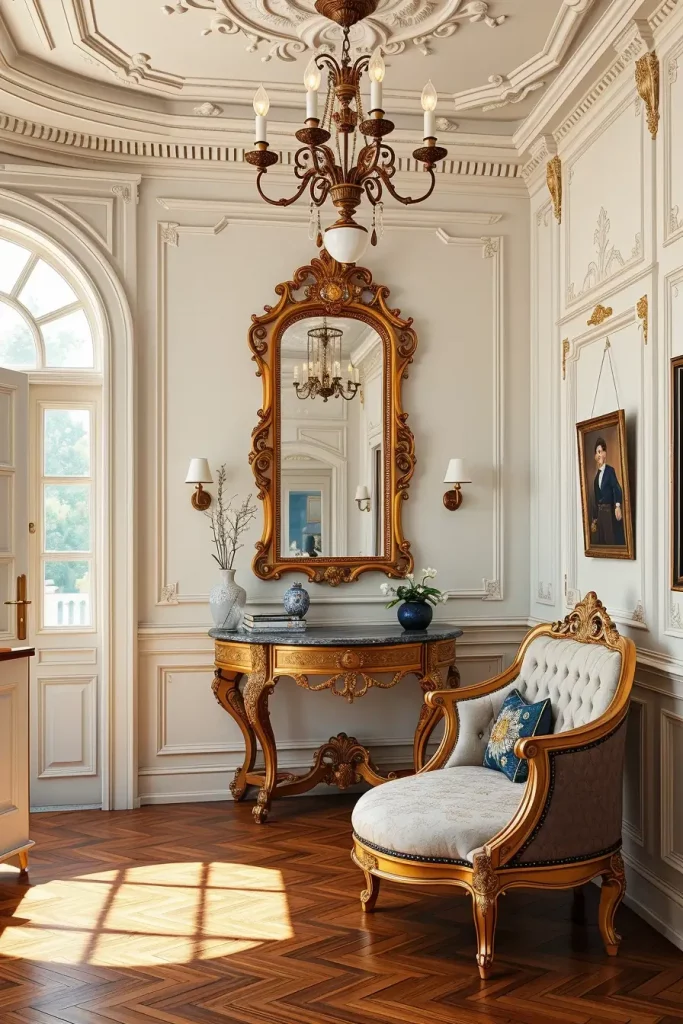
I would suggest console tables that have curved legs, marble tops and gilded edges. Mirrors or wall sconces are large and gilded to add light and drama to a narrow hallway. In bigger entryways, a chandelier with detailed design can make the design even more superior. I consider the addition of upholstered benches in rich fabrics as both beautiful and functional to the guests.
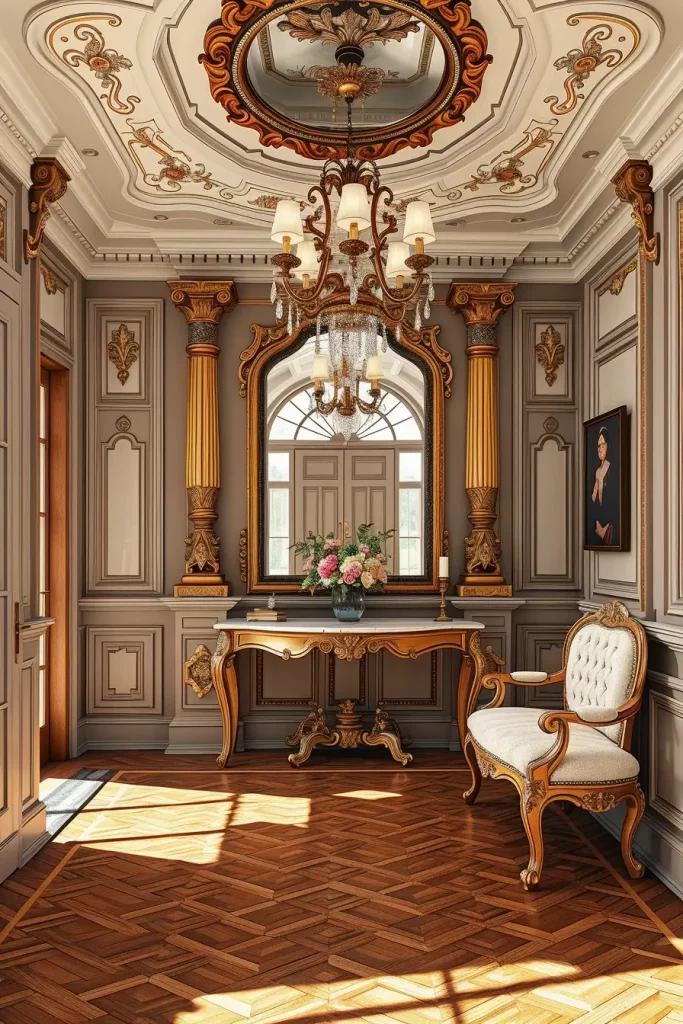
In my view, entryways are underestimated but they create one of the most powerful impressions. Architectural Digest points out that the entry of a house is what establishes the mood of the rest of the house, and I have seen how Rococo details in entryways make a lasting impression on the visitor.
What I would add here is focus on flooring. Entry floors are patterned parquet or marble, and combined with ornate rugs, the transitional spaces also feel grand and part of the Rococo Revival theme.
Window Treatments For Rococo Revival Interiors
The Rococo Revival interiors have window treatments that are as luxurious as they are functional. Draperies, layering and valances provide softness and visual drama as well as control light and privacy. The practicality is in the combination of beauty and practicality.

I would always recommend heavy silk or velvet curtains with ornate tassels, tiebacks and gilded rods. Underlayers provide a touch of class and permit diffuse light when heavy drapes are not drawn. Valances of wagged material with embroidered or gilded decorations can transform even a simple window into a piece of statement.

In my experience, clients who spend on Rococo-inspired window treatments feel a stark difference in the polished quality of their interiors. As Elle Decor explains, windows frame the light in a room, and the appropriate treatments frame the design and this is especially true in the case of Rococo Revival homes.
I would add motorized curtain systems to this section, which will be more convenient and modern, but still keep the traditional look of rich fabrics and trims.
Artistic Paintings And Wall Décor
Rococo Revival homes have walls that are used to express art. Murals painted, frames gilded and moldings ornate all help in the creation of a visual narrative. The practicality of wall decorations is that it makes the space more personal and provides it with a dimension.

I would suggest big oil paintings in gilded frames with pastoral or romantic scenes that were typical of the Rococo period. Wall panels with elaborate moldings and painted decorations create depths of elegance. The mirrors with fancy frames also add the light and space.
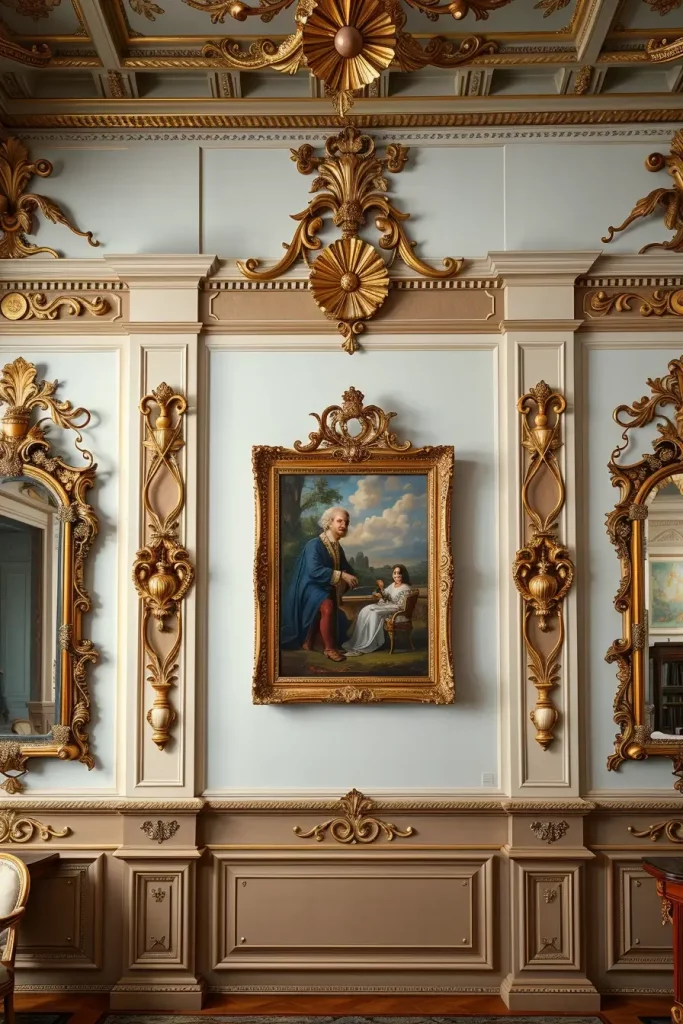
As a person, I consider wall decoration to be one of the most pleasurable elements of Rococo design. House Beautiful has also pointed out that art is used to anchor and define a room, and that a right painting or decorative panel can turn a blank wall into a focal point of beauty.
I would make this section stronger by incorporating both classical Rococo pieces with modern interpretations of the style to make the home feel current, but still with an eye to the past.
Rococo Revival Kitchens With A Luxurious Touch
Kitchens are not the first thing that people would think of when it comes to Rococo Revival, however, they can be one of the most fulfilling spaces to design in this style. The use of ornate cabinetry, gilded handles and marble counter tops creates a feeling of grandeur whilst retaining functionality. The functionality is the ability to combine luxury and everyday functionality.

I normally apply cream or pastel colored cabinetry with elaborate carvings and gold decorations. Chandeliers or pendant lights over the kitchen island will create focal points, whereas marble or quartz surfaces will be durable. Upholstered seating at breakfast nooks links the kitchen with the rest of the Rococo Revival house design.

A Rococo Revival kitchen is, to my mind, more of a great salon where the family and guests can meet. As it has been said in Veranda Magazine, luxurious kitchens are now the heart of the home, and Rococo details make them not only functional but also magical.
What I would add here is contemporary appliances that are incorporated behind elaborate cabinetry panels so that the functionality does not disrupt the flow of the historical design.
Bathrooms With Rococo Elegance
Rococo Revival bathrooms are personal oases of luxury. These rooms are freestanding tubs, gilded mirrors, and intricate tilework, which is a balance between beauty and relaxation. The practicality of this design is that it transforms a room that is merely functional to a room of pleasure and relaxation.
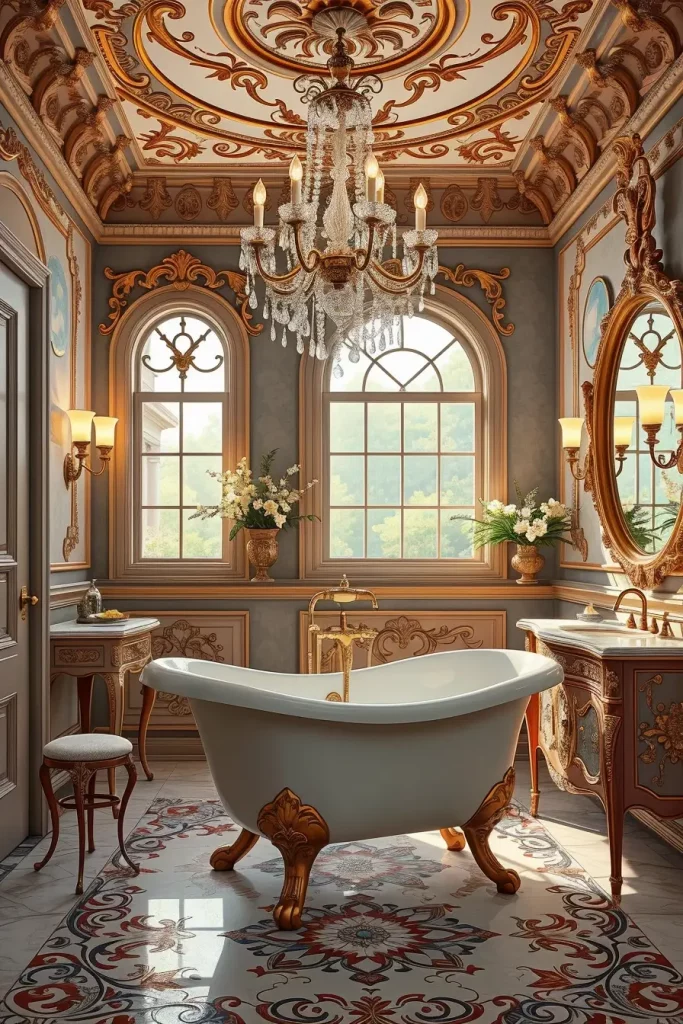
I tend to prescribe clawfoot tubs with gold accents, elaborate vanities with marble countertops, and crystal chandeliers over the bath. Wall decorations like decorative molding and patterned tiles take the aesthetics a notch higher. The softness is added by lush textiles and embroidered towels to the elegance.
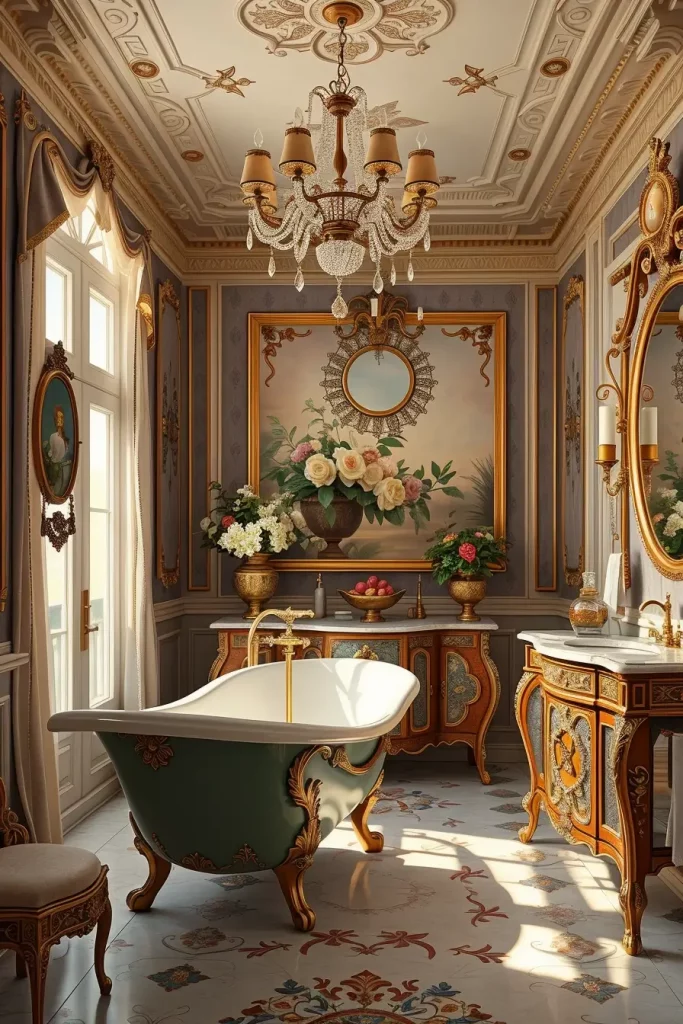
In my view, bathrooms that are designed this way are like personal havens. As Elle Decor puts it, luxury is in the details, and I have experienced how Rococo details make a bathroom experience feel both luxurious and classic.
To finish this section, I would include the modern spa elements, like heated floors or rainfall showers, which would bring modern comfort and Rococo-inspired luxury together.
Rococo Revival In Urban Apartments
Rococo Revival interior design in urban apartments must be adapted. The trick is to maintain grace without cluttering small space. The functionality is in the selective use of elaborate features with layouts that are efficient.

I would suggest selecting statement items like a gilded mirror, a Rococo style armchair, or a chandelier to centre the room. Neutral colors on the walls with one more ornamental wall, plush carpets and smaller furniture make the apartment stylish and liveable.
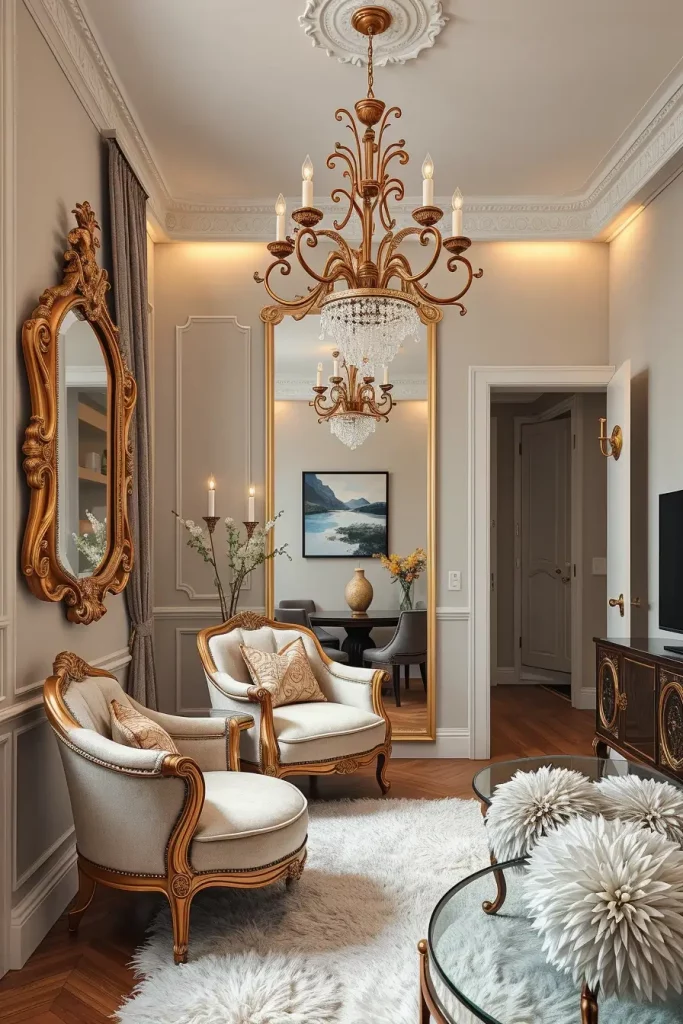
Small spaces are a challenge I find exciting in Rococo. As The Spruce says, scale is everything in small interiors, and I have witnessed how well-selected Rococo Revival details can turn even a small apartment into a palace.
I would reinforce this area with multifunctional furniture of Rococo style, so that functionality and beauty are inseparable.
Mixing Rococo With Contemporary Style
The most innovative use of Rococo Revival nowadays is to combine it with modern style. This style enables homeowners to have the best of both worlds by having a sense of ornate beauty and modern sensibilities. The utility lies in the creation of dynamic spaces that are historical and fresh.

I also enjoy mixing Rococo-style mirrors, chandeliers, or chairs with more minimalist sofas, coffee tables, and cabinetry. The details are ornate and contrasting, which makes the modern details feel more inviting and soft.
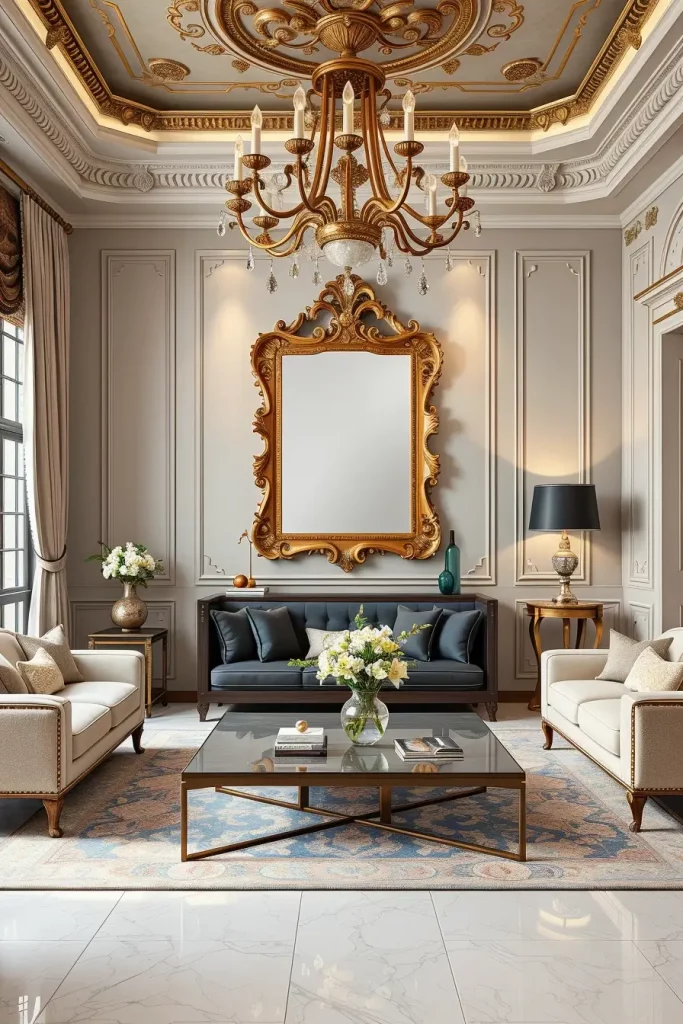
I think that this style combination makes Rococo applicable to modern homes. House & Garden has emphasized that mixing periods makes surprising harmony and I have witnessed how clients are fascinated by the contrast between gilded curves and modern geometry.
To improve this section, I would suggest paying attention to colors. Neutral backgrounds give gilded Rococo objects the chance to shine, and more vivid colors make a statement when contrasted with modern simplicity.
Collecting Rococo Revival Antiques
When I initially investigated Rococo Revival design, I understood how important antiques are to the creation of an authentic appearance. The design is based on elegance but it is also practical in that it creates focal points in a room. When you collect antiques, you can recreate the atmosphere of the 19 th -century revival era, when elaborate curves, floral carvings and gilded decor were in the spotlight. It is not only about style, but about bringing history to your home in a way that is alive and luxurious.

Personally, there are some pieces that are a must. A carved sofa with cabriole legs, marble-top tables with a delicate pattern, and large gilded mirrors can turn any room into a sophisticated place. The addition of porcelain figurines and crystal chandeliers lends an added dimension, transforming the room into something special. These antiques have not only been a decor but also conversation starter when I have guests.
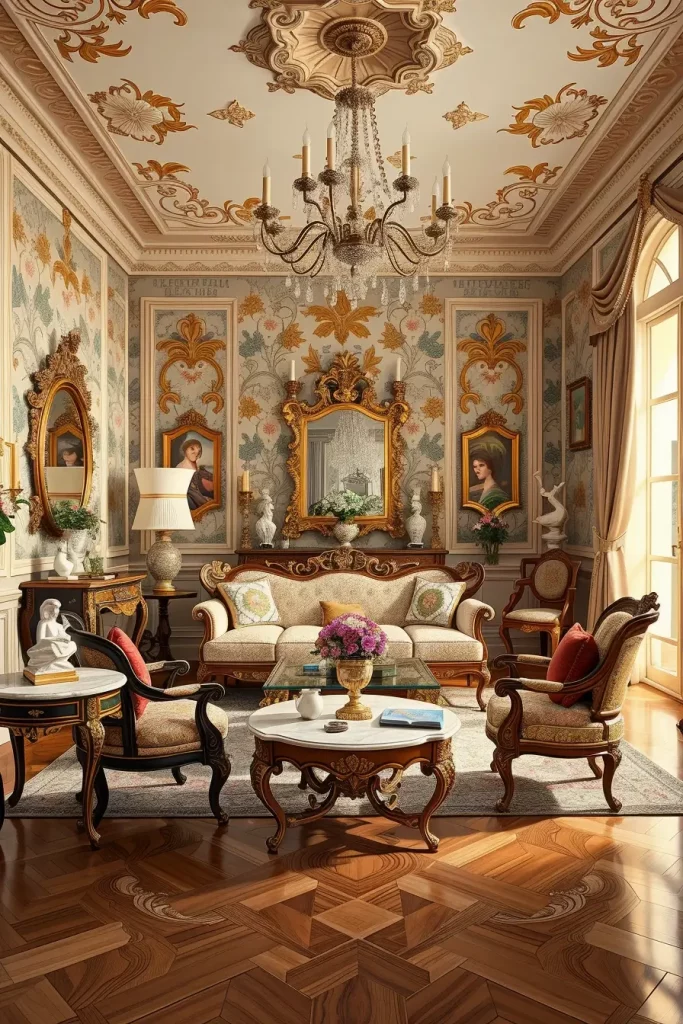
In my opinion, to gather Rococo antiques, one should be patient. Professionals, including those at Architectural Digest, advise that it is best to begin with one or two pieces that stand out and not overdo the room with too many fancy details. I adhere to this principle myself since it does not make the space look cluttered. Rather, it is a good compromise between beauty and functionality.
What I would still append here is the value of restoration. Most of the antique items will need professional attention before they brighten your interior. I have witnessed how a properly restored gilded frame can transform the nature of a living room, making it a real focal point.
Creating A Rococo Revival-Inspired Office
I found that Rococo Revival works well as an office design because it is very conducive to creativity and productivity. The curves, pastel colors, and decorative elements of the style make the atmosphere less strict than that of modern minimalism but professional. In my case, it was a matter of mixing comfort with grandeur, so that the office did not only look good but also feel good to work in long hours.
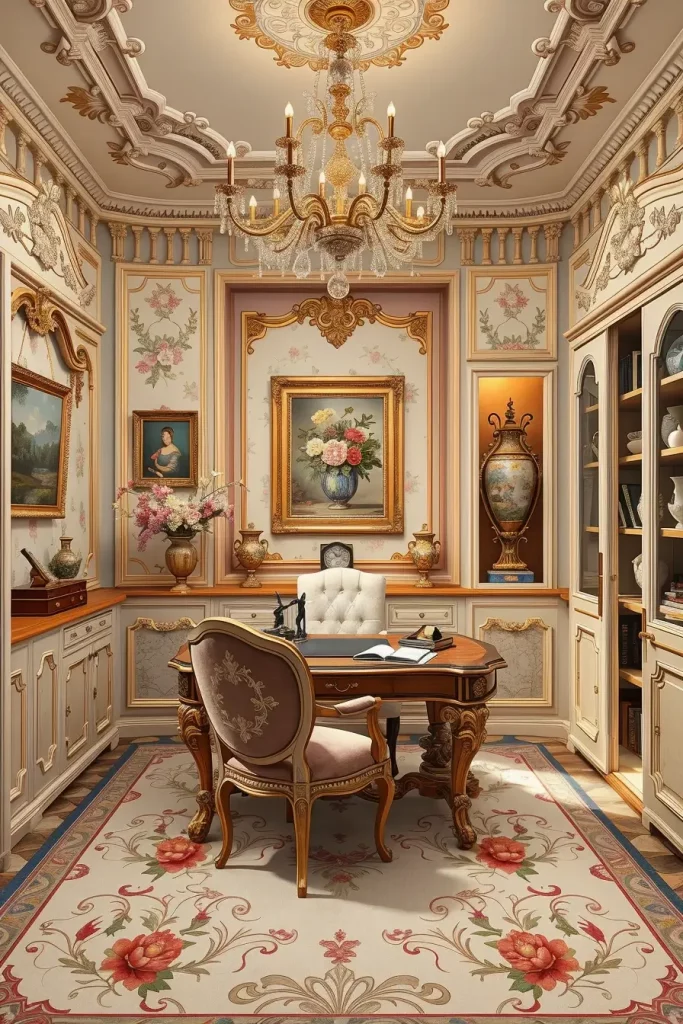
Regarding the furniture, I will always settle on a writing table that has decorative carvings and a chair with a velvet cushion to add some comfort. A crystal chandelier above the desk not only adds design to the room but also serves as light. Framed paintings with gold frames and light pastel wallpapers with subtle floral patterns adorn the walls and form a motivating atmosphere. The accessories such as porcelain vases or a small marble clock help the office to be connected to the Rococo spirit.
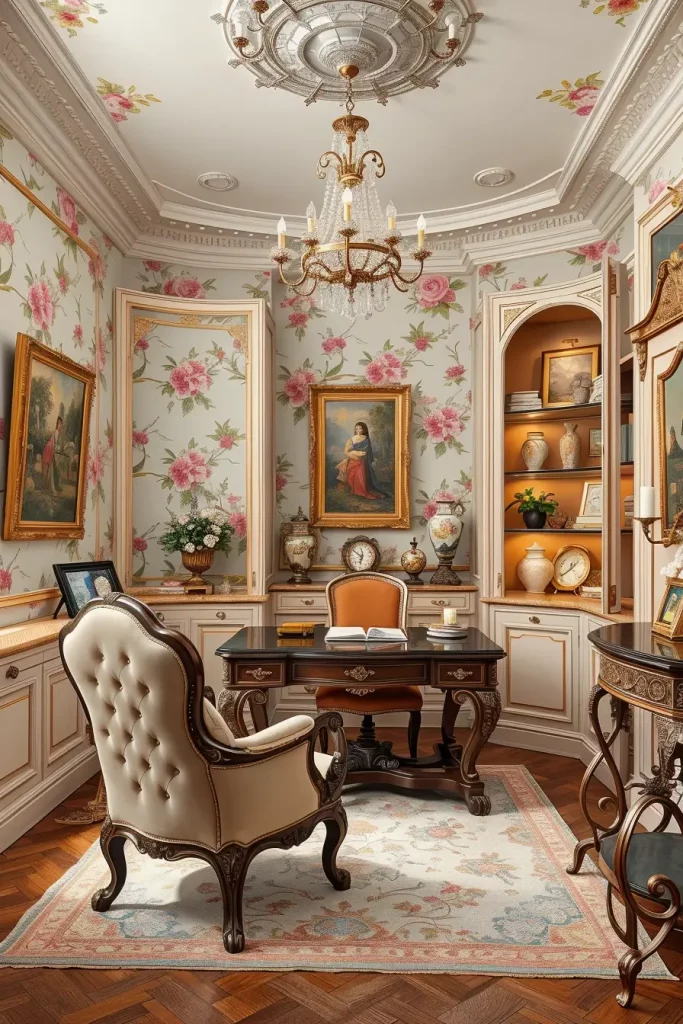
I think the greatest difficulty is to not make the space too theatrical. Professionals usually recommend the combination of the traditional Rococo with the contemporary organization devices, such as sleek shelving concealed in the ornate cabinetry. This is how I have done it myself and it makes the office functional without being too utilitarian.
I would add here the significance of ergonomics. In an office that is Rococo-inspired, you will be able to pick chairs that are well-supported but still have the upholstery that fits the style. It makes sure that beauty does not have to cost comfort.
Common Mistakes To Avoid In Rococo Revival Design
Being a person who has had experience with Rococo Revival interiors, I have seen that the most common mistake is to overload a space with details. The style is already full of patterns and curves and when all the surfaces are covered, it becomes too much instead of beautiful. I always have one or two things dominate in the design with the rest supporting.

Another problem is inappropriate matching of furniture As an example, heavy Victorian furniture with Rococo Revival may create an imbalance. I have learned to keep to light and airy works with the playful nature of Rococo. This is in the form of gilded mirrors, ornate chairs, decorative moldings, instead of dark and excessively bulky furniture. Another mistake is to include too many replicas rather than genuine antiques, which will make the room look less authentic.
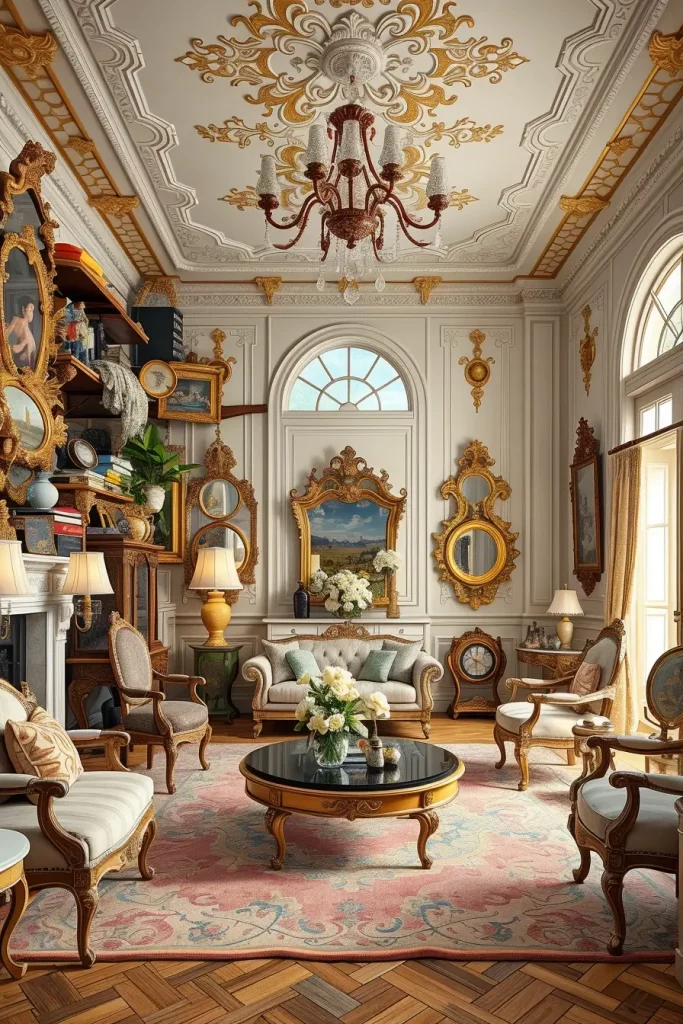
As I have learned, interior design professionals at Elle Decor will remind homeowners to think about scale. To use an example, a Rococo bed that is too large may be a beautiful piece in a showroom but it may be too big to fit in a small bedroom. I have taken this tip into consideration and it helps a lot in making a harmonious space.
What I would add here is that homeowners should pay attention to lighting. Rococo design works the best with warm, layered lighting, without which the details are lost. Wall sconces or a small chandelier in unexpected corners will help to emphasize the workmanship.
Embracing The Beauty Of Rococo Revival
Having studied the Rococo Revival style over the years, I can tell that it is one of the most gratifying styles to introduce into a house. It is a celebration of craftsmanship, glamour, and comfort, and it reminds us that living spaces can be functional and beautiful.
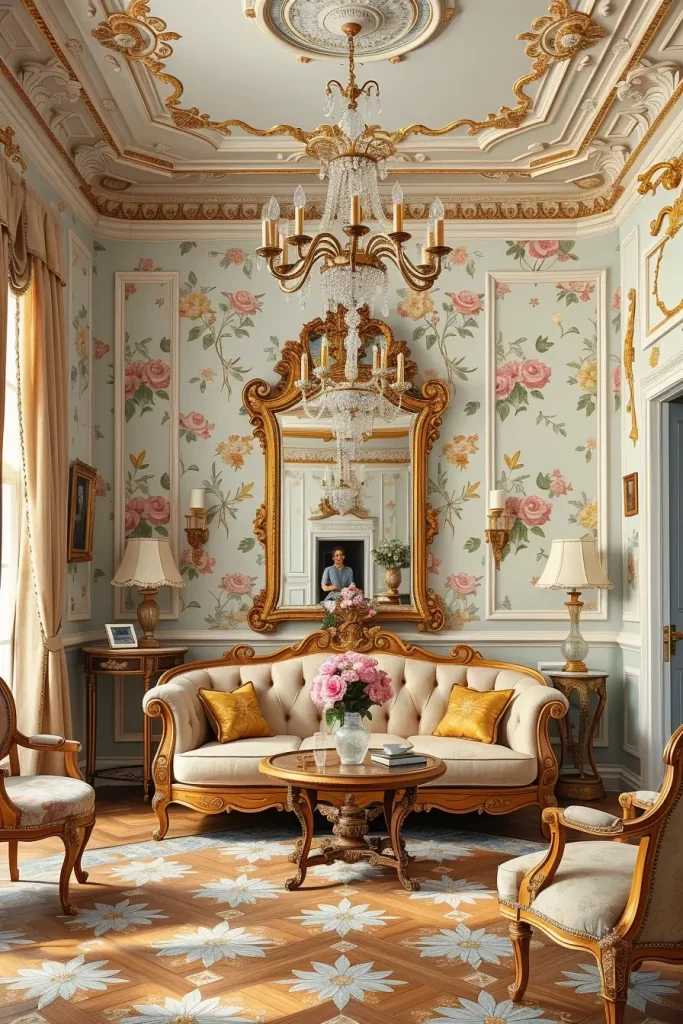
Be it antique gathering, Rococo-style office design, or just avoiding the most common pitfalls, each step towards it will help you achieve an interior that feels timeless.
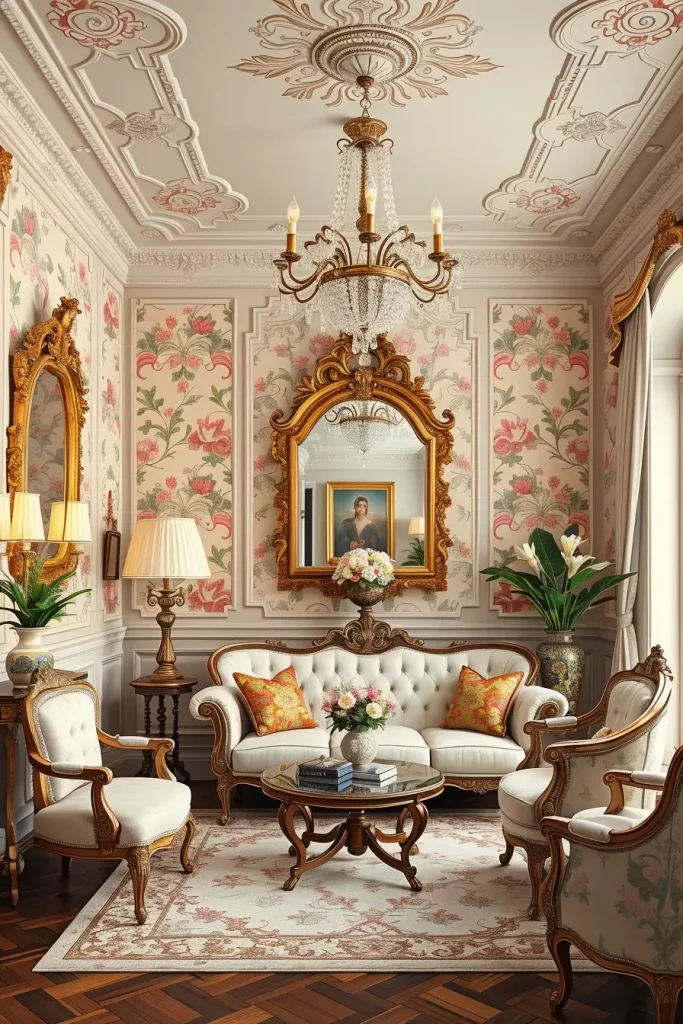
I would like you to play with the elements discussed and allow Rococo Revival to inspire your personal spaces. Tell me in the comments below, what is your favorite Rococo detail and how would you use it in your home?
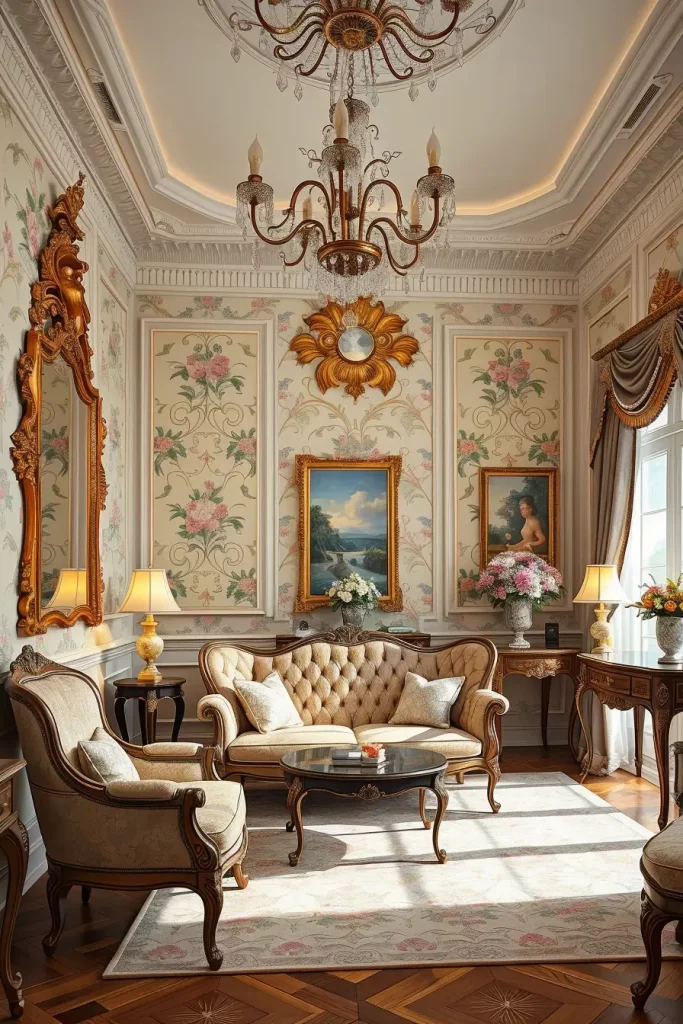
Rococo Revival home design is not merely a decorative style but a celebration of beauty, artistry and elegance. By mixing elaborate decorations, rich materials, and elegant furnishings, this style introduces the feeling of luxury to the contemporary home without sacrificing comfort. Rococo Revival is the style that gives you a chance to create a home that has a character, whether you are inspired by the aristocratic French aesthetics or just attracted by the beauty of pastel palettes and gilded accents. Which of these features of this style would you incorporate in your own? Share your thoughts in the comments below!
